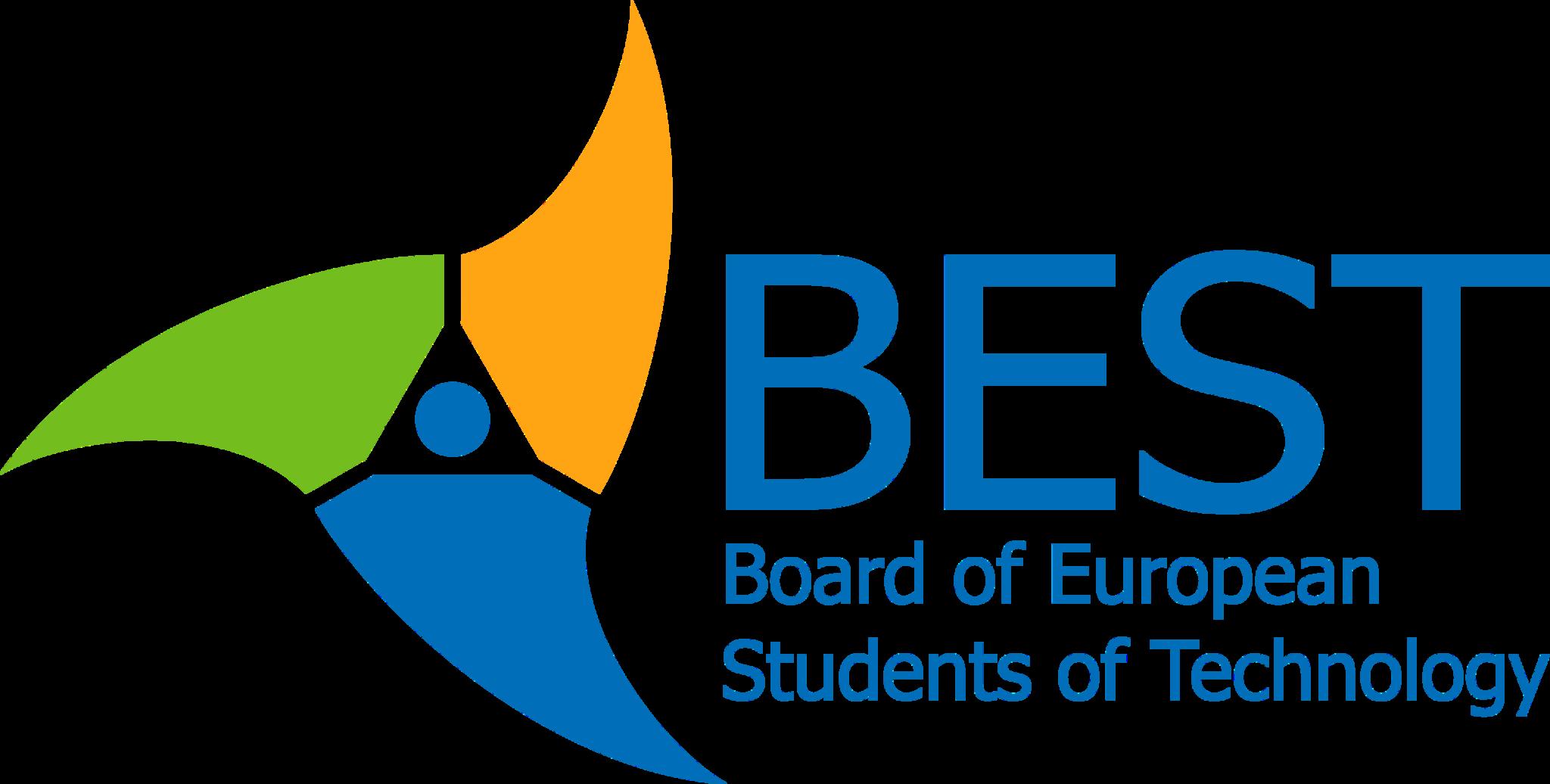

BESTSymposiaonEducation
Skopje2024
“HowtoTrainYourResponsibleEngineer?”
July2024

Report of the BEST Symposia on Education Skopje 2024 “How to Train YourSustainableEngineer?”
Produced by the Educational Involvement Department for the Board of EuropeanStudentsofTechnology
Authors
IremAlpcetin(EgeUniversity,Turkey)
SandraZancajoZapatero(UniversidadMadridCarlosIII,Spain)
DavidMikek(UniversityofMaribor,Slovenia)
ChristianAchong(PolytechnicUniversityofValencia)


BoardofEuropeanStudentsofTechnologyAISBL
The Board of European Students of Technology AISBL (BEST AISBL) is a constantly growing non-representative, apolitical and non-profit voluntary student organisation, whose vision is to empower diversity The purpose of BEST AISBListohelpEuropeanstudentsof technology to become more internationally minded, by reaching a better understanding of Europeanculturesanddevelopingthecapacitytoworkonaninternationalbasis.
To empower diversity, BEST AISBL strives to develop students of technology through various core activities and services. One of the three main core activities is Educational Involvement and the BSE is a service of it. Through the Educational Involvement Department, BEST AISBL strives to listen to the students’ ideas on what can be changed in their universities, study programmes and curricula. BEST AISBL is eager to be in close collaboration with the stakeholders of higher education, letting them know about innovative solutions,comingfromthemainreceiversofeducation-students.
BEST AISBL cooperates with several corporate, career support, project and university partnerstoprovideitsservices.
EducationalInvolvementDepartment
BSE Skopje is a project initiated and conducted bytheEducationalInvolvementDepartment of BEST. Through the Educational Involvement Department, BEST AISBL strives to make students' ideas, on what can be changed in their universities, study programs and curricula, heard.
The writers would like to express theirgratitudetoallthepeopleinvolvedintheEducational InvolvementDepartmentfortheirsupportandinitiationintheproject.
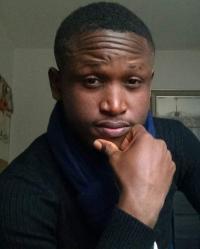

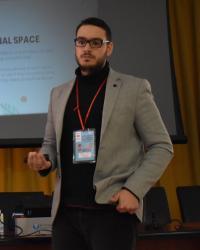
EducationalInvolvement EducationalInvolvement BSEAdviser2023DepartmentCoordinator DepartmentCoordinator 2024: 2023-2024: 2024-2025: Aggelos Kokkinis
Ariel Ediang Nadica Koloska
BESTSymposiaonEducation
BEST Symposia on Education (BSE) were created to involve students in the process of educational improvement and raise their awareness about the possibility of students being involved in their education. Together with the other stakeholders involved directly or indirectly in educational matters,studentsdiscussavarietyofeducation-relatedtopics.BEST AISBL counts on both participants of the event and stakeholders to provide insights on current educational matters most actively, in order to influence changes in education across Europe.
In a BEST Symposia on Education, participants are providedwiththeopportunitytoexpress their thoughts on educational matters, which are then presented in events’ final reports. Reports are used as aresourceforwritingpapersonparticulartopics,typicallysubmittedand presented in scientific conferences dealing with Higher Educational matters, thus making students’voicesheard.
LocalBESTGroupSkopje
This event became real with all the members of the Local BEST Group (LBG) Skopje who organised the BSE and provided tremendous support during it. Moreover, the writers would like to express personal gratitudeandacknowledgementtotheCoreTeamandBoardofLBG Skopje.

President:SaraKrshinar
Treasurer:RobertaPetrovska
Secretary:AndrejSterjev
VPforHR:AnaTodorova
FRCoordinator:AngelaTaseva
ITCoordinator:MartinJanevski

MainOrganiser:KamelijaMateska&DanielGramatikov SocialResponsible:BiseraGjurovska&NadjaCigulevska
ParticipantsResponsible:BojanaCilevska LogisticsResponsible:SimonaKrsteva&IlijaKrsteski PRResponsible:KristinaZaprova FundraisingResponsibles:AngelaKrstanoksa ContentTeamResponsible:RadeMicov
MoreInformationcanbefoundon:
HomepageofBEST/EducationalInvolvement:www.best.eu.org/educationalInvolvement
HomepageofLocalBESTGroupSkope:https://best.org.mk/ HomepageoftheUniversity:https://ukim.edu.mk/
BESTSymposiaonEducationSkopje2024
Purpose
The BSE Skopje 2024 was an event that took place fromthe7thofJuly,2024,tothe15thof July, 2024. As indicated in the title of the event, the event was held in Skopje, North Macedonia, and there 18 students of technology from diverse backgrounds had the opportunity to participate and provide their insights in discussions addressing the implementation of sustainable practices into engineering education. The insights from the studentscanbefoundintheoutcomesofeachsessionfrompage11.
The event was designed following the suggestions of various institutions which propose topics to tackle on the educational matters to createasystemandprovideideasandsolutions on sustainability related topics. The main objective of this event was to raise awareness on education-related matters, gather input from tertiary-level students of STEM fields and give students avoicewhenlookingathowsustainabilityisaddressedinengineeringeducation.As the discussions shape the Educational Involvement Department (EduID), this year the focus topicwasselectedastheResposibleEngineering.Dependingonthistopic,somegoalsforthe eventstoachieveandgatherdataweredecided.
Thesefundamentalgoalsfortheeventswereasthefollowing:
● Investigate how responsible engineering practices and values are implemented in the presentcurriculum.
● Gather students' opinions about the meaning of the topic “responsible engineering” andpossiblewaysofimplementation.
● Analyse the interest of building core values in the field of engineering through non-formaleducationactivitiesthroughouttheserviceswhichEduIDisproviding.
● Explore implementationstrategiesforthefollowingresultingdataanddefineconcrete actionsinmodernengineeringpractices.
In order to satisfy the research on educational matters that is done on the suggestions of institutions,thereweresomeobjectivestofollowthroughintheevents.Theobjectiveswere;
● WithObjective1,thisstudywillaimto:
○ Create a clearer picture about the knowledge and visibility of current topic in theacademia;
○ Research the tools and methods that are implemented in today’s curriculum aboutresponsibleengineering
● WithObjective2,thisstudywillaimto:
○ Understand which parts from “Responsible engineering” as well as which partsarelackingthemostfromastudent'sperspective.
○ Mapoutthetopiccoverageandgathertheknowledgeofstudents;
● WithObjective3,thisstudywillaimto:
○ Understand how these programs contribute to the development of corevalues within the engineering field, aiming to assess theimpactofsuchinitiativeson student’sethicalawarenessanddecision-makingskills;
○ Correlate and shortlist the most efficient non-formal education activitiestobe exploredfurtherforimplementation.
● WithObjective4,thisstudywillaimto:
○ Identify best methods for applying the insights and data generated from the researchofthispaper;
○ Create a strategy proposal for implementation of the methods for various educationalsystems(formalandnon-formal).
○ Define and prioritise tactics for short-term and long-term implementation. Mapoutpotentialwaysforethicsintegrationdeemedfeasiblebystudents.
After going through research on the Sustainable and Ethical Engineering topic within the content team, tackling the possible training method for responsibleengineers,andtheroleof ethics in responsible engineering, the specific goals and topics that need to be addressed in theeventaredecided.ThepurposesoftheBSESkopje2024werethefollowing:
● Raising students’ awareness of education-related matters, and gathering input for the roleandtheimpactoftheengineeronsustainabilityandinglobalsystems;
● Creating an understanding and information sharing on the current situation of the STEMeducationfromtertiary-levelstudentsofSTEMfields;
● Tackling the trending topicsinengineering,andinengineeringeducationthatimpacts sustainability,andtheethicalconcernsinengineering;
● To practise and develop the skills such as presentation skills, interpersonal and communication skills, as well as improve their international interdisciplinary cooperationandteamworkoftheparticipants.
In order to achieve these goals, sessions in the event are designed based on this purpose, to shape an event that creates an environment for students to understand the concept of sustainability and the sustainable development goals, and how it is included in higher education; be aware of thecurrentsystemandthecurriculuminengineeringeducationandto create an ideal semester plan that the sustainable practices are implemented while tackling ways to encourage students on these activities. This way, it is aimed that possible improvement and keypoints are provided through the event and provides data to propose to institutions.
ContentTeam
A content team of BEST AISBL members designed thesessionsfortheBSEWroclaw2023. Theircontactinformationisshownbelow

BSECoordinator Irem Alpcetin irem.alpcetin@best-eu.org Irem Alpcetin Rasume
BSEFacilitator Sandra Zancajo sandra.zancajo@best-eu.org
BSEFacilitator David Mikek david.mikek@best-eu.org
BSEFacilitator Christian Achong christian.achong@best-eu.org
Participants
A total of 16 students of technology were engaged in the sessions of BSE Wroclaw. Their personaldataisshowninTable1.
Table 1. List of participants’ details; university and nationality
Surname,Name University
Nationality
Delval,Hugo UniversityofLorraine French
Kokkinis,Aggelos UniversityofPatras Greek
Gelzinyte,Milda KaunasUniversityofTechnology Lithuanian
Kristensen,Nikolaj Helmer AalborgUniversity Danish
Özgökçen,MehmetAkif BogaziciUniversity Turkish
Sipos,Lukas SlovakUniversityofTechnology Slovakia
Reverte,Alexandra TechnicalUniversityofMadrid Spanish
Kayaalp,Lara MiddleEastTechnicalUniversity Turkish
Golovan,Olga BaumanMoscowStateTechnicalUniversity Russian
Kalina,Michal SilesianUniversityofTechnologyinGliwice Polish
Vodicka,Vojtech CzechTechnicalUniversityinPrague Czech
Los,Simon ViennaUniversityofTechnology Austrian
Mucic,Ahmed UniversityofLjubljana Bosniaand Herzegovinian
Nastic,Katarina UniversityofBelgrade Serbian
Todorovic,Neven UniversityofBelgrade Serbian
Zabicka,Kamila WroclawUniversityofScienceand Technology Polish
Acknowledgements
The BEST Symposia on Education (BSE) “How to Train Your Responsible Engineer” took place from the 7th of July until the 15th of July 2024 in Skopje, North Macedonia. Several contributions made the event possible, to whom the writers of thisreportwouldliketopaya specialacknowledgement.
ProgrammeSchedule
Below,thescheduleoftheeventcanbefound.

OfficialOpeningSession
The Official Opening Session of the BSE Skopje 2024 was an introductory session that was held as a session before theofficialactivitiesoftheevent.There,theparticipantsoftheBSE and the organisers of the event gathered to start the event by going through some presentationsregardingtheinsightandrulesoftheeventandactivitiesthatwillbeheld.
KeynoteSpeech
On the third day of the event, a keynote speech was held to engage the participants better with sustainable design and providinganinsightoneducationinUniversityofSs.Cyriland Methodius before the rest of the official activities of the day Associate Prof. Dr Elisaveta Doncheva made a presentation about sustainable life cycles and the importance of implementingsustainablemanufacturingprocesses.
OfficialClosing
The Official Closing Session of the BSE Skopje 2024 was a summary of the event by mentioning some highlights and an overview on the schedule that hadbeenfollowed.There, the participants of the BSEandtheorganisersoftheeventgatheredtoendtheeventbygoing
through some presentations and final words. The event ended by handing out the official certificatesoftheevent.
OfficialActivities
The day after the Official Opening, the rest of the official activities were held. With the official activities,the sessions conducted during theBSEbytheContentTeamarereferredto. Thesessionscanbefoundonpage11.
Listofsessions
Thelistofsessionsissummarisedbelow:
1. ResponsibleEngineeringOverview
2. EthicsOverview&Sustainability
3. EthicalCodes&Practices,Privacy&IP
4. OverviewontheCurrentSituation
5. FuturePractices
6. EthicalPhilosophy
7. Case Study on the Student Approach for Implementing sustainability into University Education
8. FinalPresentations
Alltheusedmaterialsregardingthesessionsareinthesefolders:
● Presentations&RealLifeSchedule
● SessionOutlinesandFurtherInformation
● Minutes
● MiroBoard
● PicturesofFlipcharts
● Printingmaterials
● Syllabus
WorkingMethods
The sessions designed by the Content Team of the BSE were developed with the intent to engage with the students rather thanpresentingageneralcase.Therefore,variousmethodsof facilitationwereusedduringsessionswhicharesummarisedbelow
DiscussionGroups
A discussion group is an interactive oral process in which a group of people isgivenatopic or a situation and after thinking about it for a few minutes, they discuss their points ofview with each other in groups or individually. The opinions and ideas are expressed in a systematicway.
WorldCafé
World Café methodology is a flexible format for hosting large group dialogues. Participants are divided into groups, each starting from a different spot or table.Eachtablehasaspecific topic which is being discussed.Ideasarewrittendownandthegroupmovestothenexttable. After moving to the new table, groups familiarise themselves with what was previously discussed there, after which the new group adds their ideas. Thisprocessisrepeateduntilall the groups have been to all the tables. Finally, the ideas from each table are presented to all theparticipants.
Brainstorming
Brainstorming is a structured process which encourages the generation of a large number of ideas in a group setting. All ideas are recorded,andnojudgmentsorevaluationsaremade.It is perhaps the most popular technique used in groups to expand the thinking process. Brainstorming works on the premise that even crazy and “wild” ideas should be listed, as they may spark new and practical ideas that would otherwise not havesurfaced.Participants of the brainstorming session are encouragedtocontributeanyideasandtobuilduponothers’ ideas.
ModelUnitedNations
AmodelunitednationconferenceisdoneinthesamewayastheUnitedNationsconferences. This format is a gathering of ideas and open discussions done bythedelegationsofdifferent countries on specific topics. Such as culturaltopics,educationrelatedmatters,economicalor international relations related topics. Each student gets prepared for their respective country as if they are a representative of the country and shares its formal opinion on the selected topic. Conferences end when the discussion is over and a resolution paper to list down the solutionideasanddiscussedtopicsiscreatedbasedonthealliancesbetweenthedelegates.
CaseStudy
A case study is to create a know-how and a way to practise the already given information regarding any topic. This method is used to encourage participants to be creative and liberalise their ideas on the matter. After the briefing of the activity is done, the process is self facilitated by the participants. The topic of the case study can be anything related tothe topic. Thismethodcanbeusedtoemphasiseaspecificwayofthinkingonamatter,orsimply canbeusedinordertopractiseinformationsuchasmakingapaperplane.
Sessions
ThethemeofBSESkopje2024wasSustainabilityeducationforSTEMstudents.Universities around Europe performtheirowncurriculumonSustainabilitytoencourageSTEMgraduates to practise sustainable behaviour However, considering sustainability is an emerging and growing topic of today, accelerating this process can occur within the students by creating
awareness and opening a window on how the education should look like for them to internalisesustainabilitybetter Thesessionswere,asfollows:
1. ResponsibleEngineeringOverview
2. EthicsOverview&Sustainability
3. EthicalCodes&Practices,Privacy&IP
4. OverviewontheCurrentSituation
5. FuturePractices
6. EthicalPhilosophy
7. Case Study on the Student Approach for Implementing sustainability into University Education
8. FinalPresentations
Eachofthesessionsisreportedinthefollowingstructure:
● Summary;
● Methodology;
● Outcomes.
1.ResponsibleEngineeringOverview Summary
This session aims to responsible engineering and three pillars of sustainability The perception of responsibility is an important topic to discuss in the engineering and STEM field, as much astheroleoftheengineeringinsustainability.Bycreatinganunderstandingof the absence of each pillar of sustainability and creating an ideal profile as an engineer to achieve; it is possible to reflect on the meaning of balance and be aware of the risks associatedwithit,whilecreatingaframeforthefutureengineers.
MinutesoftheSessioncanbefoundhere:
[Minutes][Day1]ResponsibleEngineeringOverview1 &2
Methodology
Part1oftheSession
● Introduction(5min)
Attendeesareawareoftheobjective,theagenda,andthegroundrules.
● Quotehuntingasgroups(10min)
There are 3 quotes regarding responsible engineering, and participants are divided into 3 groupstocirclearoundthequotes.



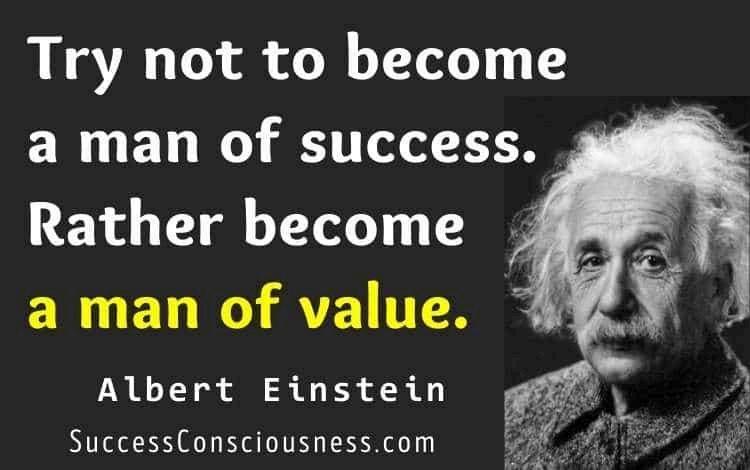

● Discussiononresponsibleengineeringandtheroleoftheengineer(15min)
Participantsaregatheredbackasabiggroupanddiscussthequotes.
● Whatdidthequotesmeantoyou?
● Whatdoyouhaveincommon?
● What do you think the role ofanengineeris?Whatisresponsibleengineering toyou?
● Howdoyouthinkusasengineerscanaffectourworld/society?
● World Cafe on practices of engineering on fields of activity; environmental, social,economic(25min)
Participants are divided into 3 groups,andaWorldCafeisperformedbymakingeachgroup focus on one pillar for 10 minsatthebeginning,7minsforthenextpillar,and5minsforthe final one; to generate ideas on what is the practice of the engineering on each pillar of sustainability (word sustainability was not used in the sessions to create and accelerationfor thesecondsessionandtointroducethetermthere).
● Debriefingandreflectingonhowdifferent/similarthepracticesare(15min)
Each group goes through the flipchart they have in hand and shares with the rest. A small discussionstarts.
● What were the similarities in the practices of each pillar? What were the differentpracticesineachpillar?
● Howdoyouthinkanengineercanrealisethesepractices?
● What is the role of the engineer so they can actualize the practices, andmake themeasier?
● Whatdotheyneedtounderstandandactuponforthesepractices?
● What Would the world look like if we just ignored one or two fields of activity? (5-7min)
This question is askedtotheparticipantsandtheyaredividedintothesamegroupstodiscuss andgatherideas.Theproblemideasarewrittenontothepost-itsindifferentcolours.
Part2oftheSession
● IdealEthical/Responsibleengineers(10mins)
Participants draw a stickman and write down the characteristics of the ideal engineer as a group.
● How would an ideal ethical/responsible engineer face problems caused by negligenceofthepreviouspillars?(20mins)
They get the problems they identified from the previous session. They answer the question foreachproblem.Theyanswertheproblemsingroupsandwritethemdown.
● Discussion on howidealethical/responsibleengineerwouldfaceproblemscaused bynegligenceofpillarssustainability(15min+10mins)(25mins)
Presentation, 3-5 mins per each team. Teams discuss within and specific questionsareasked toeachteambasedontheirwork.
● ClosingDiscussionwithaSustainabilitytwist(15mins)
Participantsgatheredasagroup,sitdowninacircleanddiscuss.
● Howwoulditfeeltohavethestickmanaroundinreallife?
● Consider your work, problems and the solutions; Which one of the pillars shouldbeprioritised?
● Whichoneoftheproblemsisthemostfacedandappealinginourdailylives?
● In fifty years from now, with/without the presence of the stickman, what wouldtheworldlooklike?
● Whydoyouthinkyourroleisimportantatthemoment?
Outcomes
Part1oftheSession
● Introduction(5min)
● Quotehuntingasgroups(10min)
Participantswereacquaintedwiththefollowingquotes.
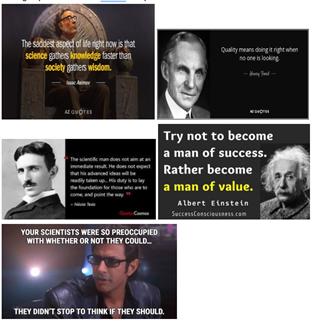
● Discussiononresponsibleengineeringandtheroleoftheengineer(15min)
The quote that stood out was "Quality means doing it right when no one is looking". There were also points about "Not reinventing the wheel" and "what happens when technologyishere,butpeoplearen'treadyforit".
Otheroutcomeswere:
● Allofthequotesraisedpointaboutdoingthingsresponsibly
● Roleoftheengineeristoinnovate,beawareofwhatthisinnovationbringswithit, improve the world and quality of life, make things safe, and make best possible decisionsgivenondatatheycurrentlyhave.
● Responsible engineering means taking care of the environment, standing up against unethicalprojects,doingthings"therightway",beingsociallyresponsible, andcontinuouslearning.
● Engineers should be aware and spread awareness, learn from mistakes, finish unfinished projects (from previous generations), control future technologies, ensure completion of transitions (like renewable energy), and discuss all possible outcomes.
● World Cafe on practices of engineering on fields of activity; environmental, social,economic(25min)
Whenaskedwhatengineeringbringstofollowingpillars,participantsproduced:


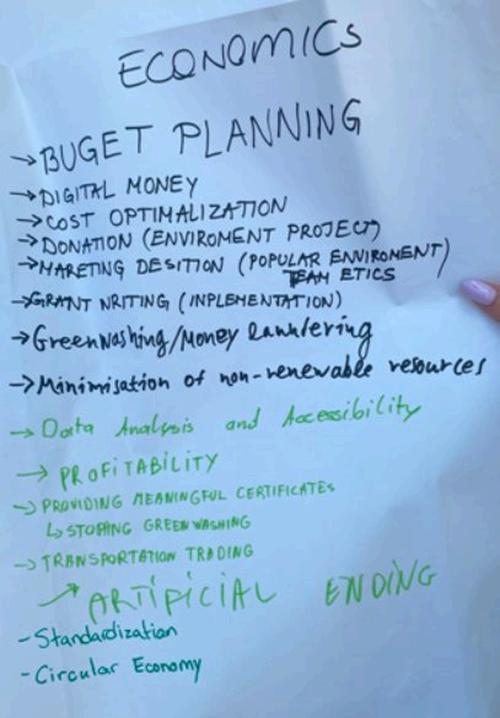
● Debriefingandreflectingonhowdifferent/similarthepracticesare(15min)
Thegeneralagreementwasthatitwashardesttotalkaboutenvironmentalaspects.
Itwasnoticedthatmobilityandtransportationwerepartofallthreeareas.
It was pointed outthatstandardisation,notonlyintheEU,butonagloballevel,wouldbe agoodthing,butitcouldlimitinnovation.
If engineers worked together they would have more power Collaborating with scientists from other fields would ease innovation. It's also important to not only focus on one aspect and neglect others. We need to keep in mind that it is our generation that isgoing toleadthefuture.Sustainabilityshouldbeprofitable.
● What Would the world look like if we just ignored one or two fields of activity?(5-7min)
When asked to imagine what would happen if one or more pillars were ignored participantsproduced:

Part2oftheSession
● IdealEthical/Responsibleengineers(10mins)
Whenaskedhowideaethicalengineerwouldlooklike,participantsproduced:
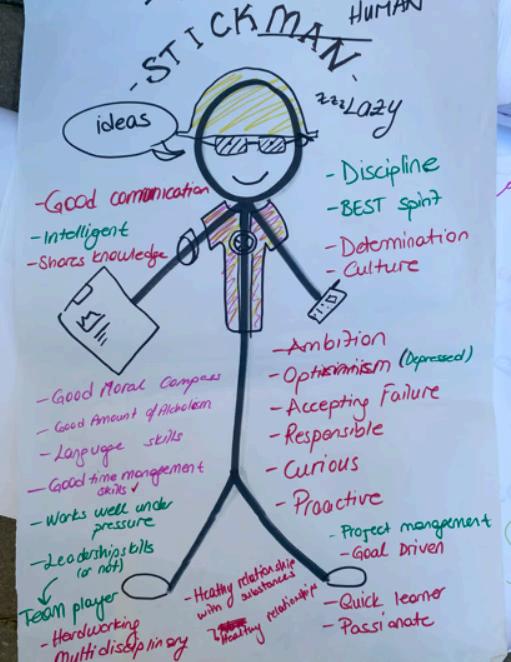
● How would an ideal ethical/responsible engineer face problems caused by negligenceofthepreviouspillars?(20mins)
● 3Dprinting
● Improveorgantransplantandmedicalinnovationingeneral
● Createneworganisationsthatcouldhelp
● Getcompaniestouseethicallysourcedmaterialsforecology
● Designing countermeasures to limit disasters / new safety features on technology
● Localengagement
● Environmentallegislation
● ClosingDiscussionwithaSustainabilitytwist(15mins)
Insightsfromdiscussionaboutthisengineerwere:
● People would feel safer if the stickman engineer was real, but at the same time, theyacknowledgeitwouldbehardtocompetewithhimonthejobmarket.
● Weshouldn'tprioritiseanyof3fields,sincetheyareallimportant.
● Thefutureworldwithoutstickmen/responsibleengineerscouldbedisastrous.
● Meanwhilethecurrentsystemisnotactuallydiscouragingusfrombecomingmore responsibleengineers,itisnotdoingmuchtoencourageuseither
● Our role is important because we will be the ones leading us (responsibly?) into thefuture.
2.EthicsOverviewandSustainability Summary
Ethics is an important part of responsible engineering. Engineers are faced with different rules and world conditions everyday and this brings different ethical responses and actions. This session aims to make students understand the ethical situations, terms, and be able to giveexamplesonthetopicinordertocreateamindsetofethicsinthinkingoftheirstudies.
MinutesoftheSessioncanbefoundhere:
[Minutes][Day2]EthicsOverviewandSustainability
Methodology
● Introduction(5min)
Attendeesareawareoftheobjective,theagenda,andgroundrules.
● Groupdiscussion-Whatcanengineersdoforsociety(5min)
Participantsgatheredasagroup.
● Whatcanengineersdoforsociety?
● Whatdoessocietyneedfromengineers?
● Pillarsofsustainability(10min)
Participants sit together as the facilitators present the topic of pillars of sustainability For interactivity purposes participants are asked to answer some descriptive questions from time totime.
● Howwouldyoudefinesustainability? Participantsareofferedseveraldescriptionsofsustainability
● According to these definitions would you say you are following a sustainable lifestyle?Why?
● Howisthisdefinitiontranslatedtoyourstudentandengineeringprofile?
Definition of Sustainability: In 1987, the United Nations Brundtland Commission defined sustainability as “meeting the needs of the present without compromising theability of future generations to meet their own needs.” Today, there are almost 140 developing countries in the world seeking ways of meeting their development needs, but with the increasing threat of climate change, concrete efforts must be made to ensure development todaydoesnotnegativelyaffectfuturegenerations.
● Whatwerethepillarsofsustainability?
EconomicSustainability:
● Definition: Economic sustainability involves practices that support long-term economic growth without negatively impacting social, environmental, and cultural aspects of the community It focuses on maintaining the financial health of individuals, businesses, andnations,ensuringthatresourcesareused efficientlyandresponsibly
● Whatcanbethekeyconceptshere?
○ Resourceefficiencyandmanagement
○ Sustainableeconomicgrowth
○ Equitabledistributionofwealthandresources
○ Employmentopportunitiesandeconomicstability
● Why is economic sustainability important? What are some indicators of economic sustainability?
SocialSustainability:
● Definition: Social sustainability focuses on maintaining and improvingsocial quality with concepts such as cohesion, reciprocity, and honesty, as well as individual and collective well-being. It involves creating an equitable society
that meets the needs of all its members, promoting well-being, equity, and socialjustice.
● Whatcanbethekeyconceptshere?
○ Humanrightsandfairlabourpractices
○ Accesstoeducation,healthcare,andotheressentialservices
○ Communitydevelopmentandsocialinclusion
○ Culturalpreservationanddiversity
● What does social sustainability mean to you? How can engineers contribute tosocial sustainability?
EnvironmentalSustainability
:
● Definition: Environmental sustainability emphasises the need to conserve natural resources and protect global ecosystems to support health and well-being, now and in the future. It involves practices that reduce pollution, waste, and environmental degradation while promoting conservation and the sustainableuseofnaturalresources.
● Whatcanbethekeyconceptshere?
○ Conservationofbiodiversityandecosystems
○ Reductionofcarbonfootprintandgreenhousegasemissions
○ Sustainablemanagementofnaturalresources(e.g.,water,land,air)
○ Minimization of waste and pollutionthroughrecyclingandsustainable practices
○ Howcanengineersminimiseenvironmentalimpactintheirprojects?
● Interconnection(7mins)
After revealing the pillars of sustainability, the interconnections between each pillar is explained.
● How do the three pillars of sustainability (economic, social, and environmental) interconnect?
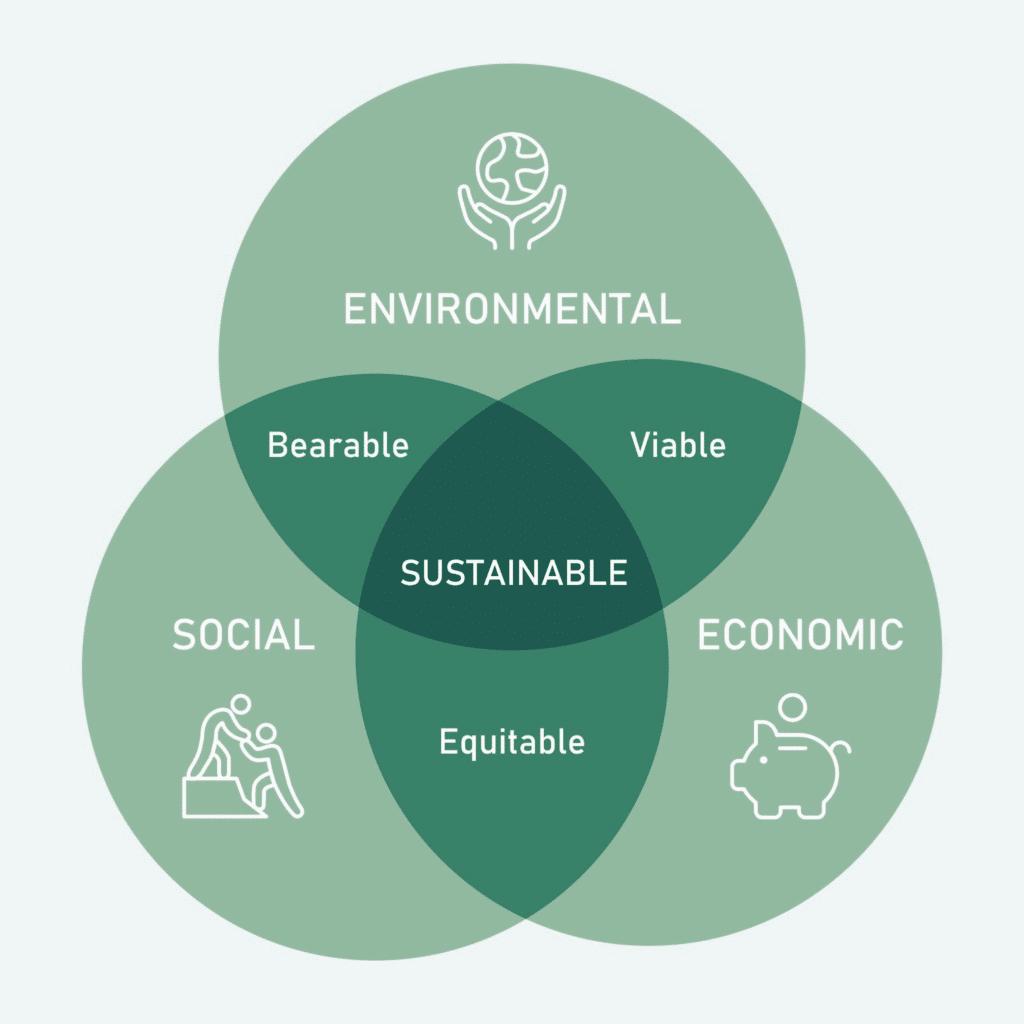
● Can you provide an example of a practice or project thataddressesallthreepillarsof sustainability?
Finaldescriptionofsustainabilityisrevealedafterthediscussion. Sustainability is the practice of meetingourcurrentneedswithoutcompromisingthe ability of future generations to meet their own needs. It involves a holistic approach that considers environmental health, economic vitality, and social equity. Sustainable practices aimtobalancethesethreedimensionstoensurelong-termwell-beingandprosperity.
● What are some challenges while balancing the three pillars of sustainability?
● IntroductiontoSDGs(10mins)
The challenges that mentioned before are modern day problems that requires modern day solutions.
Facilitators introduce and explain what SDGs are,howtheyarerelatedtothetopic.Byusing videos:
1. https://www.youtube.com/watch?v=92IAMsrCloQ
2. https://www.youtube.com/watch?v=pgNLonYOc9s
● Didyouknowaboutthembefore?
● Whatdoyouthinkaboutthem?Dotheyseemreachabletoyou?
● Groupdiscussion-Whatisethicstoyou?(10min)
A discussion is held to see everyone’s interpretation of ethics while giving the participant differentquestionstoguidethediscussion.
● Howwouldyoudefineethicsinyourownwords?
● What key principles or values do you believe are fundamental to your ethical beliefs?
● Canyouprovideanexampleofanethicaldecisionyou’vemaderecently?
● Howdoyouthinkcultureinfluencesethicalstandards?
● Can you think of a situation where cultural differences led to differentethical perspectives?
● Howdoethicalbehavioursinfluencesocietyasawhole?
● Howdomoralsandvaluesplayaroleinshapingethicalbehaviour?
These questions and follow-ups aim to encourage participants to reflect deeplyonthenature of ethics, the influence of personal and cultural factors, and the importance of ethical behaviourinbothpersonalandprofessionalcontexts.
● EthicalTheoriesandPrinciples(15min)
A presentation regarding the different theories there are about ethics is done. An objective definition of ethics according to the literature is presented, and differences between other concepts (morals, rightness, etc) that cansometimesbeconfusedwithethicsare highlighted. Throughout these sessions some participation of the attendees will be needed, to answer questionsordoquickactivities.
Autonomy:Respectingindividuals'rightstomaketheirowndecisions.
➢ Allowing dragons to choose whether they want to stay with their human partners or livefreely.
Beneficence:Promotingthewell-beingofothers.
➢ Hiccup's efforts to improve the lives of both humans and dragons through understandingandcooperation.
Non-maleficence:Avoidingharmtoothers.
➢ hiccuprefusingtoharmandkillthedragoninhislastchallenge
Justice:Ensuringfairnessandequality.
➢ Treating dragons as equals and ensuring they have the same rights and respect as humansinBerk.
Responsibility:Takingasteptomakethingshappen.
➢ Hiccup takes responsibility for the well-being of both Berk's residents and the dragons.
● IntroductiontoEthicsinSTEM(5min)
Somequestionsareaskedtotheparticipantsingroupdiscussionformat.
● Why is it important to have ethical guidelines in professional fields like engineering?
● Howcanethicalguidelineshelppreventprofessionalmisconduct?
● GroupActivity:EthicalImplicationsofSustainability(15min)
With the knowledge and different perspectives given throughout the session participants are divided into 4-5 groups and asked to choose an SDG. Then, they have to analyse such SDG in order to identify how itcanbeethicallycompromisedandhowtotacklethis.Theyhaveto analysepositiveandnegativeaspectsfromanethicalpointofview.
● Presentations(10min)
Theypresenttheirideas.
● Reflectionafterpresentations(10min)
After presentations, an individual reflection about all ofthetopicsismade,andsomeaspects of the SDGs that we did not use for the presentations are mentionedfurthermore.Theaimis to identify general implicationsinethicsregardingsustainability,aswellasfocusingonmore specificonesforeachoftheSDGs.
The importance of sustainability is highlighted; Long-term Viability; HealthandWell-being; EconomicResilience.
Anactivitytoreflectonthelearningpointsismadeafterthepresentations:
● Wheniamtheperfectengineer;
○ 3SDGsiwillbefocusing
○ 2Ethicalprinciplesiwillpayattentionto
○ 1ethicalactioni’lltakeforsdgs
Outcomes
● Introduction(5min)
● Groupdiscussion-Whatcanengineersdoforsociety(5min)
Thetopicofengineersinsocietyisintroducedandashortdiscussionismade.
The discussion highlighted thatengineersplayacrucialroleinaddressingsocietalchallenges byfosteringinnovation,improvinghealthcare,foodsystems,andresourcemanagement.They can contribute by creating high-quality, sustainable products and ensuring accesstoessential technologies. Participantsemphasisedtheimportanceofinclusivity,solvingglobalissueslike the climate crisis, and training others in technology. The group agreed that engineers should focusonproblem-solvingandpromotingglobalprogressthroughqualityandmobilityintheir designsandsolutions.
● Pillarsofsustainability(10min)
The discussion aimed to define sustainability andexplorehowpersonalbehaviourinfluences engineers' approach to sustainability in their professional lives. Participants also examined
the three pillars of sustainability—economics, society, and environment—and how these are integratedintoengineeringpractices.

Defining Sustainability: Participants offered various definitions, generally centering on the idea of maintaining a balance between resource use and environmentalpreservation.Nikolaj defined it as “not taking more than you give,” while others like Kamila emphasised the importanceofbalancinggrowthwithappreciationofcurrentresources.
Challenges in Personal Sustainability: Most participants admitted that theirlifestyleswere not entirely sustainable due to external factors such as cost, time, and access to resources. Lara pointedoutthatsustainableproductsareoftenmoreexpensive,leadingpeopletochoose less sustainable options. Aggelos and Nikolaj highlighted inefficiencies in recyclingsystems and the reliance on fossil fuels, making everyday sustainability difficult to achieve. Neven noted that perfect sustainability is hard to reach due to external distractions and systemic limitations.
Corporate Responsibility vs. Personal Behavior:Thegrouprecognizedthesignificantrole corporations play in contributing to unsustainable practices. Lara and Simon stressed that while corporations are largely responsible for carbon emissions, individuals also bear the responsibility of setting sustainability standards in daily life. Hugo added that people often prioritise convenience over sustainability, which is a challenge for both individuals and engineerstoovercome.
ImpactonEngineeringPractices:Participantsdiscussedhowpersonalbehaviourstranslate intotheirrolesasengineers.Aggelosstressedtheimportanceofbuildingsustainablehabits andavoidingactionsdrivensolelybyexternalpressures.Kamilaexpressedadesiretocreate systemsthatmonitorandimprovesustainabilityineverydaylife,reflectingtheneedfor
engineerstodevelopsolutionsthatpromotelong-termsustainablepractices.
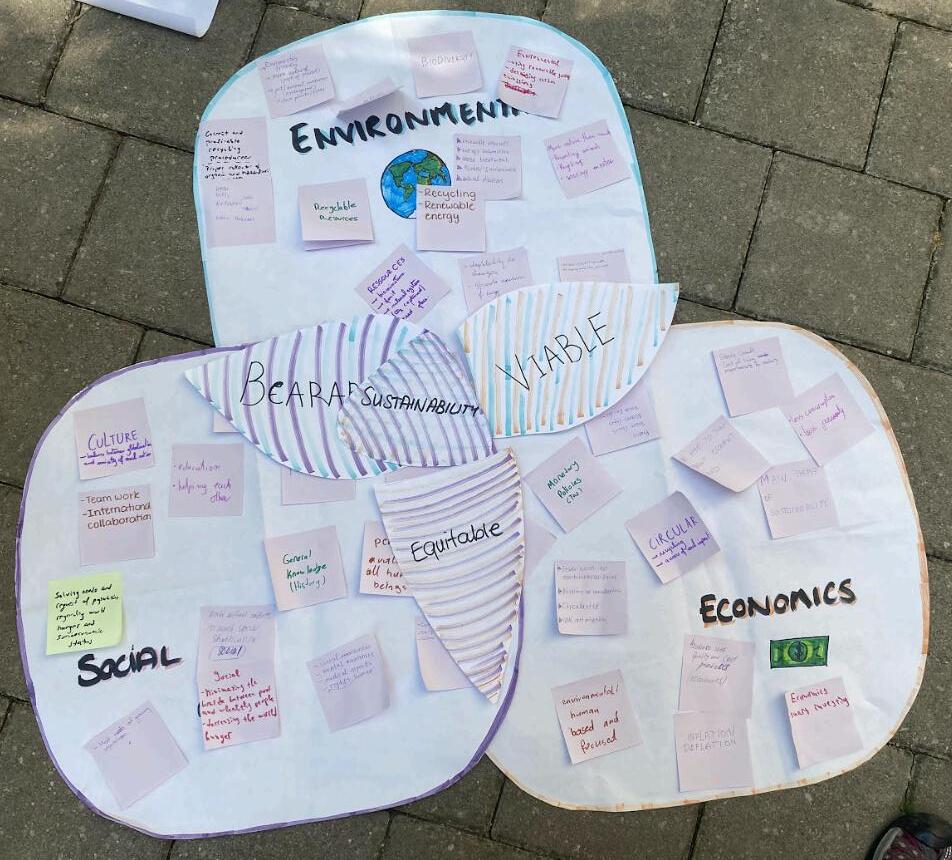
Sustainability: sustainability managinggrowthresponsibly without causing inequality, while environmental sustainability focused on conserving resources for future generations. Social sustainability emphasised inclusivity and reducing wealth disparities. Participants acknowledged the difficulty of balancing these pillars, especially in engineering, where market efficiency often conflicts with environmental and social goals. They concluded that while achieving perfect sustainability is challenging, engineershavearesponsibilitytoleadbyexampleanddesignsolutionsthatintegrateallthree pillarseffectively
Overall, the discussion emphasised the importance of adopting sustainable habits in both personal and professional contexts. Participants recognized the challenge of aligning sustainability pillars, but highlighted the role of engineers in leading by example and designing solutions that balance economic viability, environmental protection, and social fairness.
● Interconnection(7mins)
The group discussed the interconnectedness of the three pillars of sustainability—economic, environmental, and social—viewing them as a Venn diagram where each influences the others. For instance, environmental harm can negatively impact socialwell-beingbymaking areas unlivable, and this also places economic burdens on governments. They noted that a balance among the pillars is essential for overall human and planetary well-being. The connections were categorised as "bearable" between environmental and social, "viable" between environmental and economic, and "equitable" between social and economic, with sustainabilityemergingfromtheintegrationofallthree.
● IntroductiontoSDGs(10mins)
The group expressed scepticism about the achievability of the Sustainable Development Goals(SDGs),withparticipantslikeKamilabelievingtheymayneverbefullyreacheddueto global inequalities and varying country commitments. Hugo suggested prioritising basic needs, like water, which are foundational to achievingothergoals.AggelosandNevennoted that the SDGs are interconnected and linked to some pillars of sustainability, though not all. Nikolaj pointed out that focusing on sub-goals might be more practical than addressing overarching sustainability The group agreed that each country should assess and prioritise the SDGs based on itsuniquecontext,butacknowledgedthedifficultyinmeasuringprogress comprehensively.
● Groupdiscussion-Whatisethicstoyou?(10min)
The second part of the session explored ethics, focusing on personal definitions and values. Participants described ethics as prioritising others' happiness and the right course of action, with fundamental values including open-mindedness, selflessness, sharing knowledge, family, safety,andintegrity Ethicaldilemmasdiscussedincludedtheuseofdronetechnology in combat and the challenges of truthfulnessinrecruitment.Decision-makingwasbasedona combination of emotions, logic, and broader perspectives. The discussion highlighted the significant influence of cultural values on ethical judgments, noting that what is considered ethical can vary greatly across cultures and evolve over time. This diversity in ethical perspectives leads togenerationalandculturaldisagreements,underscoringtheimportanceof empathy in addressing these differences. The session emphasised the complex relationship betweenculturalinfluences,personalvalues,andethicaldecision-making.
● EthicalTheoriesandPrinciples(15min)
In this part of the session, participants explored various ethical principles and their applicationsinengineering.Keyprinciplesdiscussedincluded:
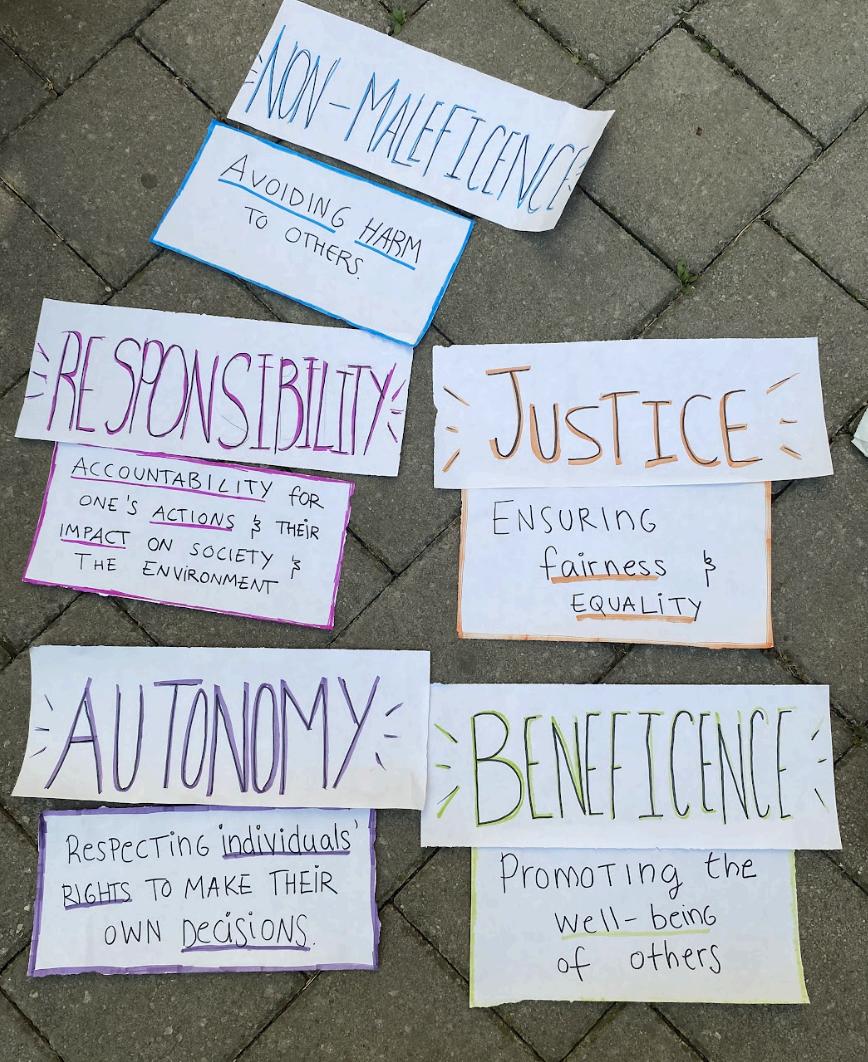
Autonomy: Respecting individuals'rightsandfreedoms,exemplifiedbyensuringthatpeople are not manipulated or coerced, such as allowing personal choice in political contexts or respectingpersonalbeliefs.
Beneficence: Acting for the benefit of others, including examples like providing healthcare andadvocatingforrights,orsimpleactsofkindnessandencouragement.
Justice: Ensuring fairness and equality, such as equal treatment in legal systems or job applications,andaccountabilityinpracticesandpolicies.
Responsibility: Taking accountability for actions, including freedom of speech with its associatedresponsibilities,politicalaccountability,andprofessionalintegrity
Non-maleficence: Avoiding harm, such as not engaging in unethical practices like theft or war,andensuringthesafetyandwell-beingofothers.
● IntroductiontoEthicsinSTEM(5min)
The discussion emphasised the importance of having ethical guidelines in engineering to prevent chaos andensureresponsible,fairpractices.Withoutsuchguidelines,thefocusmight shift solely to personal or commercialinterests,potentiallyleadingtoharmfuloutcomes.The group agreed that ethical principles are crucial for maintaining order, fostering trust, and guidingengineersinmakingdecisionsthatalignwithsocietalandprofessionalstandards.
● GroupActivity:EthicalImplicationsofSustainability(15min)
Thegroupspicked:
● Liveunderwater
● Partnershipsforthegoals
● Genderequality
● Presentations(10min)
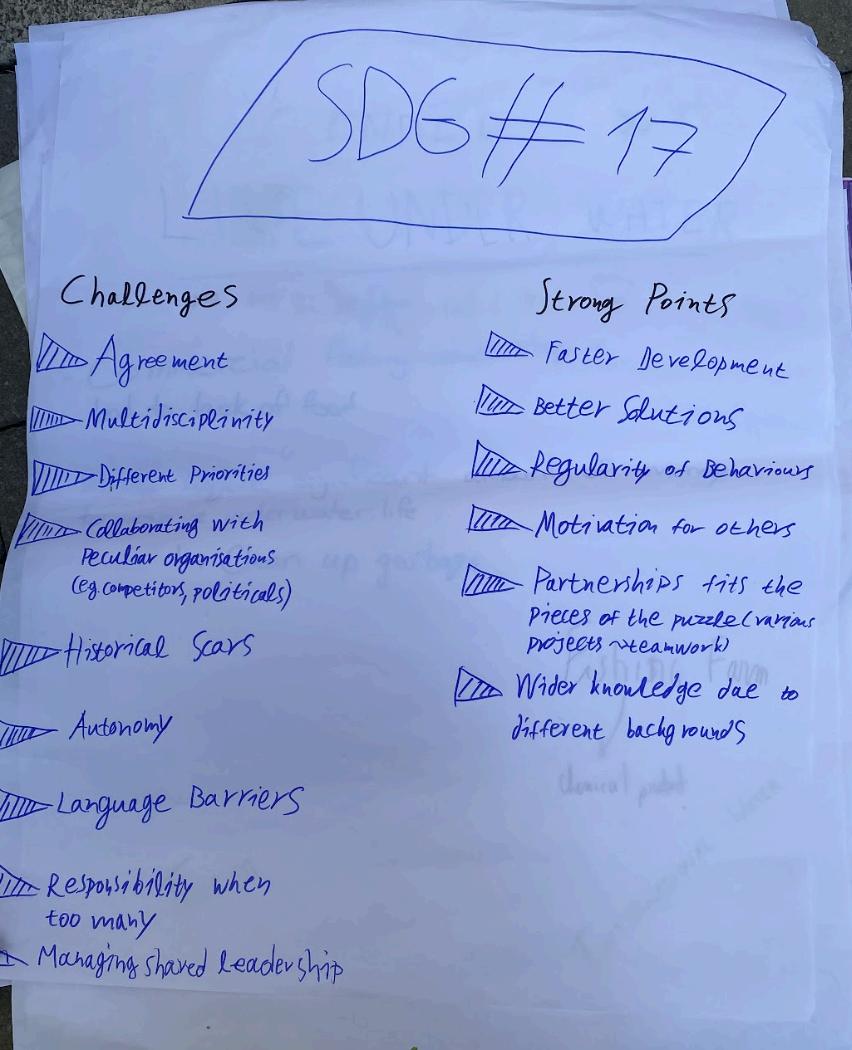

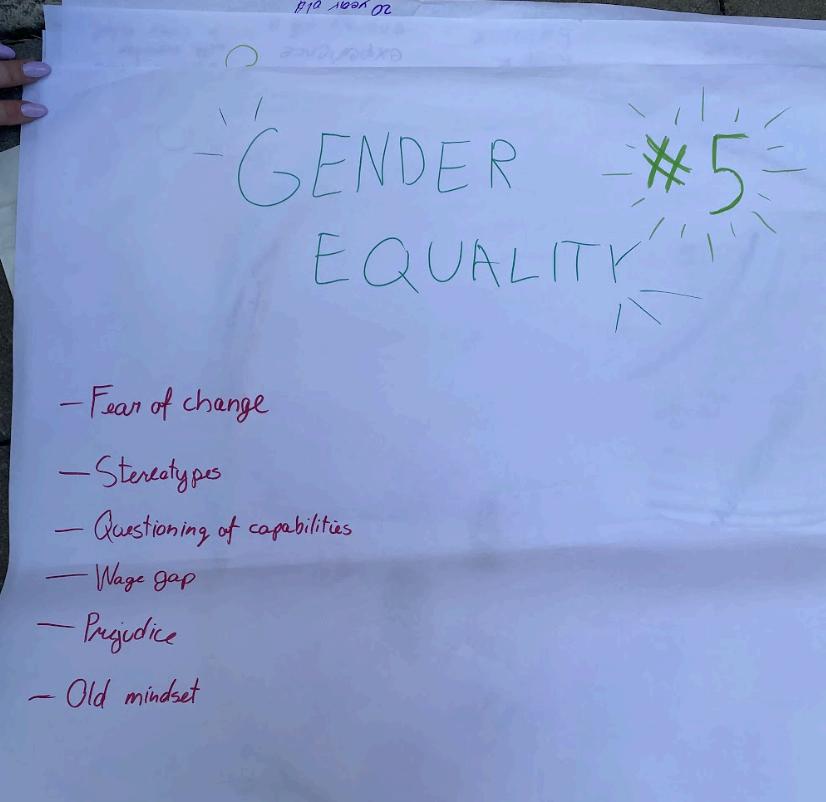
● Reflectionafterpresentations(10min)
3.EthicalCodes&Practices,Privacy&IP Summary
Engineers have been working and participating in many fields in the world since the beginning of time. For their ethical practices, noteveryruleisthesameandnoteveryperson has thesamebehaviour Eventhoughtherearecodesofconductsandethicsforengineersand STEM field; like/from NSPE, Engineers Europe, IISE; their visibility is not high and somehow overlooked. With that being said, another ethical concern is being the personal rights and privacy of companies and engineers. Today’s world requiresmanydifferentforms and signatures to make sure the privacy is confined, however, not all the engineers nor companies are aware of their rights, or the set of rules presented on the current day such as thecreativecommons,intellectualproperty,orGDPR
This session aims to create awareness on these documents, explain ethics; privacy concept and intellectual property, and understand the student point of view on ethics from an engineeringperspective.
MinutesoftheSessioncanbefoundhere: [Minutes][Day2]EthicalCodesandPracticesandPrivacyandIP1&2
Methodology
Part1oftheSession
● Introduction(5min)
● Review(5min)
Reviewofprevioussessions.
● Creationofprofileof“Companyengineer”(7min)
Participants create a profile of a company-oriented engineer with focus of what are characteristicsofengineersthatthepotentialemployersarelookingfor Participantsaregiven flipchartswithastickmanforabasetobuildon.
● Presentation (5min)
Participantspresenttheircreations.
● Discussionofprofilesandcomparetopreviousone(10min)
Discussion on created profiles. Comparison of profiles to profiles of Ethics-oriented engineerscreatedinoneofprevioussessions.
● Whatdotheyhaveincommon?
● Whatisthereasonforallthosesimilarities?
● Whichofthementionedfactorshasthemostimpact?
● Whatarethedifferencesbetweenthem?
● Whydoyouthinkthatisthereasonforthosedifferences?
● Presentethicaldilemmas-howwouldeachengineerprofilerespondtoit(10min)
Participants are grouped by teams andpresentedwithethicaldilemmas.Theydiscusshowan ethical-orientedengineerandcompanyorientedengineerwouldreactineachsituation.
1.To Ship or Not to Ship: A quality assuranceengineermustdecidewhetherornotto shipproductsthatmightbedefective.
2. Copyright Concerns A computerstartupcompanyrisksviolatingcopyrightbylaws ifitreusesacodethatistheintellectualpropertyofanothercompany
3.A Lengthy Dilemma A medical company asks blood sample suppliers to sign an ethicallyquestionableconsentform.
4. Is the Customer Always Right? Should a production engineer prioritise a customer'sdesiresoversafety?
5. A Breach in Security When a computer filledwithpersonaldatagetsstolen,adata companymustdecidehowtomanagethebreachinsecurity
6. A Positively Negative Response A bioengineer's research leads to the discovery thatapatientmighthaveprostatecancer.
7. Inhibited Reaction A chemicalengineeringprofessordiscoversthatacolleaguehas takencreditforhisresearch.
● Discussionofdifferentanswerstopreviousactivity(10min)
Discussionandcomparisonofdifferentconclusionsofpreviousactivity
● Whatarethesimilaritiesintheapproachofbothstickmen.
● Andwhatarethedifferences?
● Whichoutcomeisbetterforthelongtermandshortterm?
● Whatistherelationshipofeachstickmanwiththepillarsofsustainability?
● Howdoyouthinkbothprofilescouldbemerged?
● Introductiontoethicalcodes(concept)(5min)
Shortintroductiontotheconceptofethicalcodes.
● Whatwouldyouputinidealethicalcode(5min)
Discussionofwhatidealethicalcodeshouldconsistof.
● Presentationofethicalcodes(10min)
Presentationofcurrentexistingethicalcodes.
● Debateonuniformethicalcodes(20min)
Participants are divided into groups - one debating in favour of uniform ethical code and another against the case. Participants are given preparationtimetopreparethecase,andthen argueforitindebate.
Part2oftheSession
● Whatisprivacytoyou?(10min)
Short discussion for participants to explain what they see and consider as privacy and some examples.
● Whatisprivacytoyou?
● Wouldyouconsiderprivacyafundamentalhumanright?
● Doyoucarethatcompaniesarecollectingdataaboutyour(online)behaviour?
● Howdoyouthinkthataffectsyouineverydaylife?
● Couldyouimagineaworld-atransparentsociety-withoutprivacy?
● Whatwouldbethebestandworstthingsaboutit?
● Introductiontoafunfact/storyaboutprivacy(5min)
To keep it more dynamic and not purely theoretical, privacy in a fun fact way isintroduced; suchaswhenacompanyhasleakedprivateinformationanditsconsequences.
● IntroductiontotypesofPrivacy(10min)
Starting with the more theoretical aspects, a little dive on the different types of privacy and differentlawsregardingprivacyisdone:GDPR.
● Debateonprivacy(police)(20min)
Participants debate on some situations and how far can privacygo,forexample,ifthepolice should be allowed to havethepersonalinformationofthepeoplewhenit’sneededforcertain scenarioandhowmuchinformationshouldtheyhave
● FunstoryIntellectualProperty(5min)
Followingtheideaofprivacy,IntellectualPropertyisintroducedwithafunstory
● IntroductiontoCreativeCommons,Copyright,Patents(10min)
Some of the most important aspects regarding intellectual property, creative commons and copyrightareexplained,andtheirdifferencesanddescriptionsaremade.
● HowdoesIPaffectPrivacy&Wrap-Up(10min)
Final point to see how these matters are related and a quick wrap up with everything that is discussedinthesession.
● How knowing your privacy rights will impact you as an engineer in your journey?Writeonpostandputitontheemptyflipchart.
Outcomes
Part1oftheSession
● Introduction(5min)
● Review(5min)
● Creationofprofileof“Companyengineer”(7min)
● Presentation (5min)
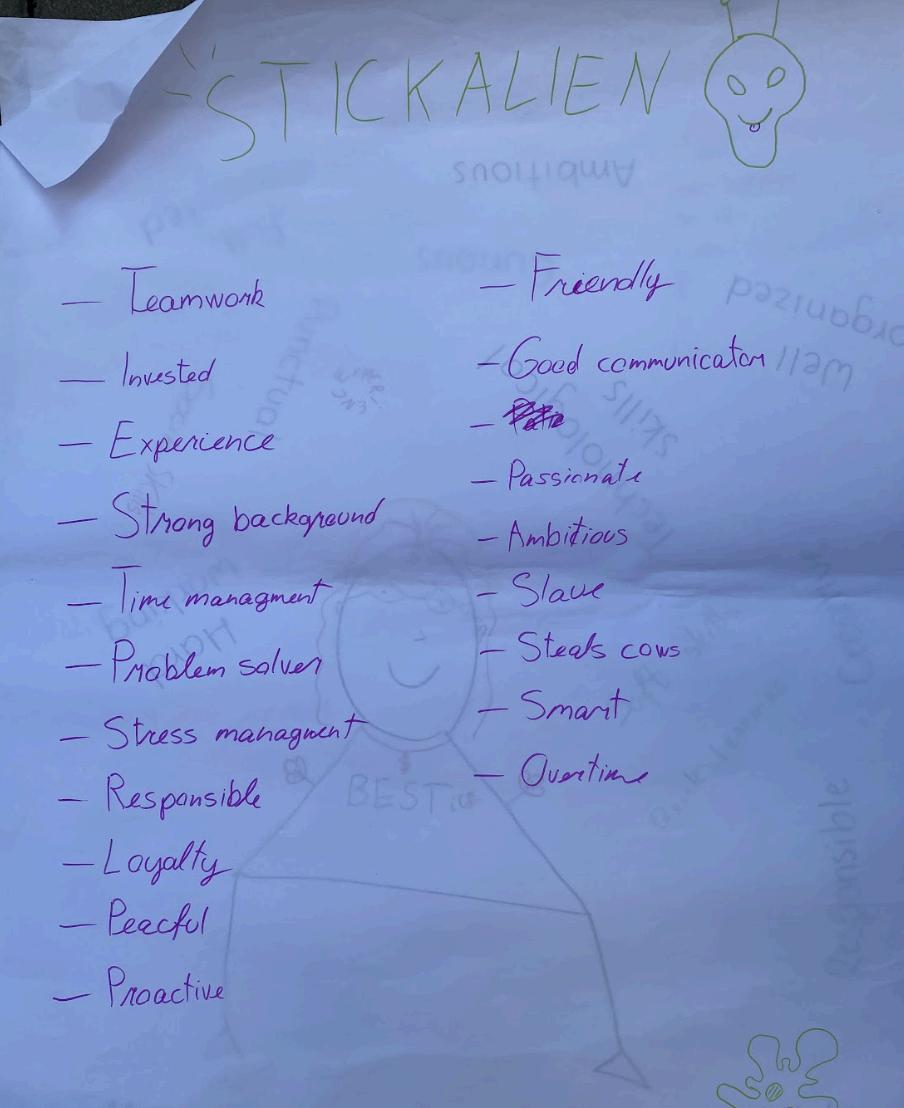
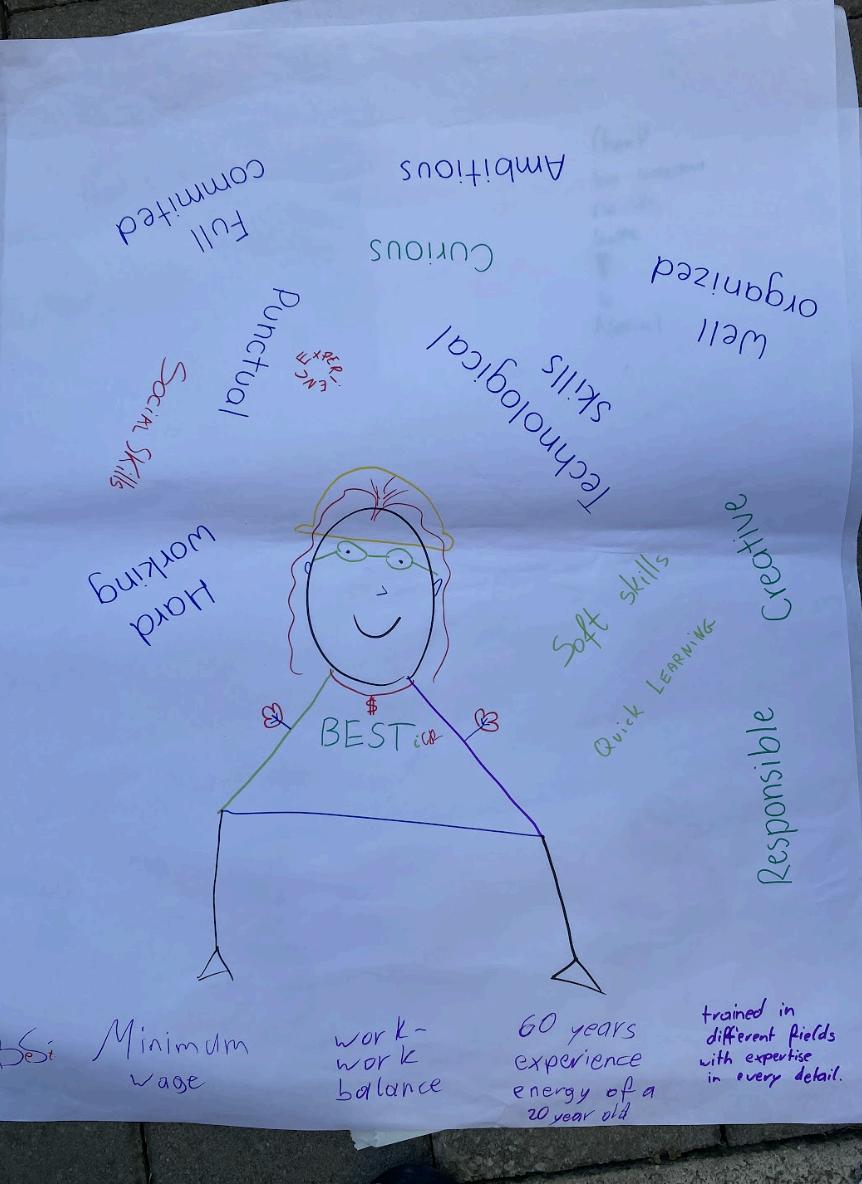
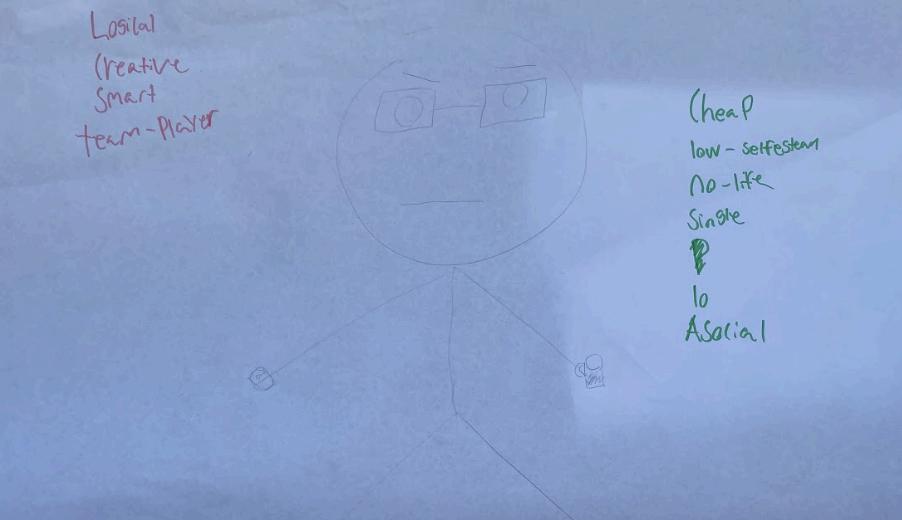
● Discussionofprofilesandcomparetopreviousone(10min)
Discussion on created profiles. Comparison of profiles to profiles of Ethics-oriented engineerscreatedinoneofprevioussessions.
● Whatdotheyhaveincommon?
● Whatisthereasonforallthosesimilarities?
● Whichofmentionedfactorshasthemostimpact?
● Whataredifferencesbetweenthem?
● Whydoyouthinkisthethereasonforthosedifferences?
● Presentethicaldilemmas-howwouldeachengineerprofilerespondtoit(10min)


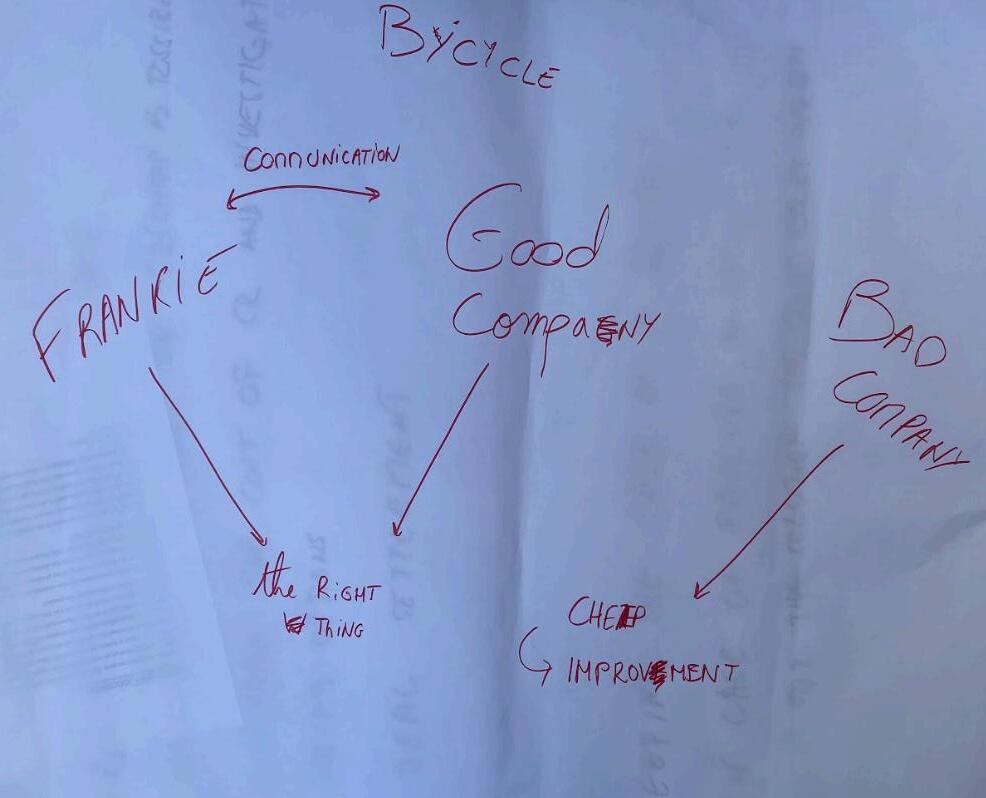
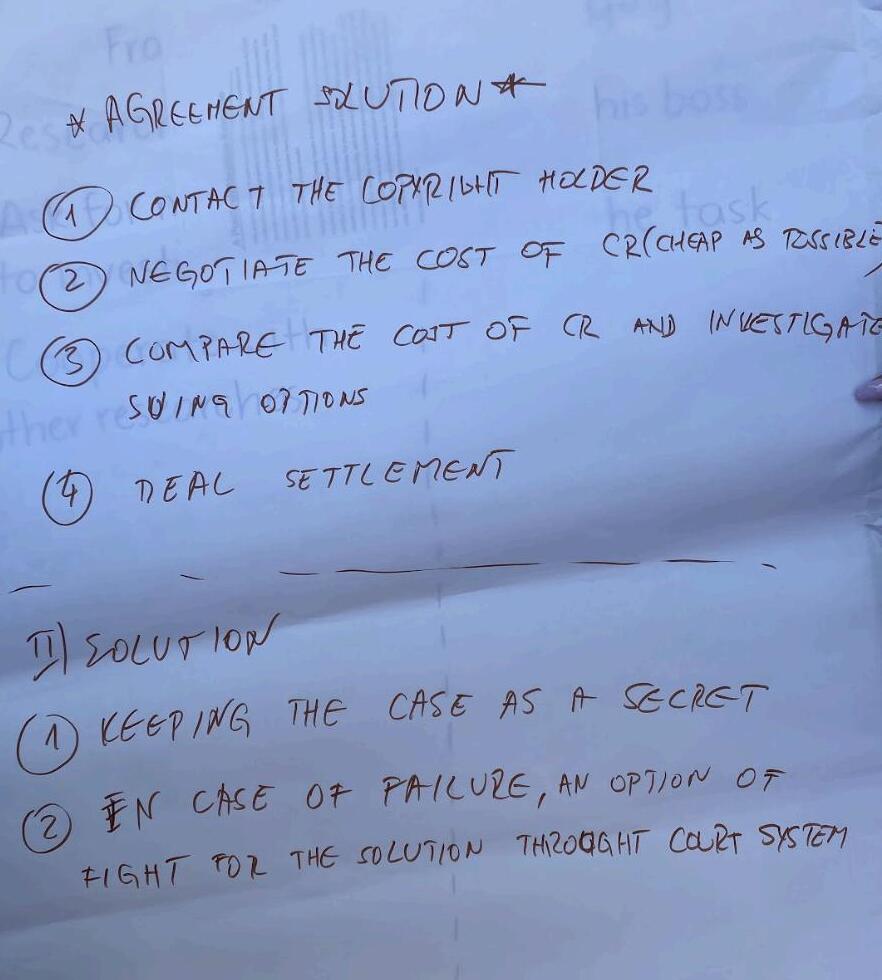
● Discussionofdifferentanswerstopreviousactivity(10min)
Discussionandcomparisonofdifferentconclusionsofpreviousactivity
● Whatarethesimilaritiesintheapproachofbothstickem.
● Andwhatarethedifferences?
● Whichoutcomeisbetterforthelongtermandshortterm?
● Whatistherelationshipofeachstickmanwiththepillarsofsustainability?
● Howdoyouthinkbothprofilescouldbemerged?
● Introductiontoethicalcodes(concept)(5min)
● Whatwouldyouputinidealethicalcode(5min)
● Presentationofethicalcodess(10min)

● Debateonuniformethicalcodes(20min)
Part2oftheSession
● Whatisprivacytoyou?(10min)

Duringdiscussion,thefollowingconclusionsarereached:
● Participantsagreedthattherighttoprivacyisafundamentalhumanright.
● Most participants do not likecompaniescollectingtheirdata,oratleastwanttoknow what exactly it is used for. On the other side there is a benefit that targeted advertisementscanbemorerelevant.
● There is an issue of how easily "echo chambers" are established today - how algorithms can use collected data to show only viewpoints users "want" to see (and ignoreotherviewpoints).
● Mitigating the effects of those bubbles/echo chambers can be done by limiting time spentonline,andinformingyourselfwithnewsfromdifferent(trustworthy)sources.
● Participants are of the opinion that a fully transparent society could be chaotic and depressing.
● IntroductiontotypesofPrivacy(10min)
ParticipantswerefamiliarisedwiththedifferencesbetweenGDPRandCCPA.
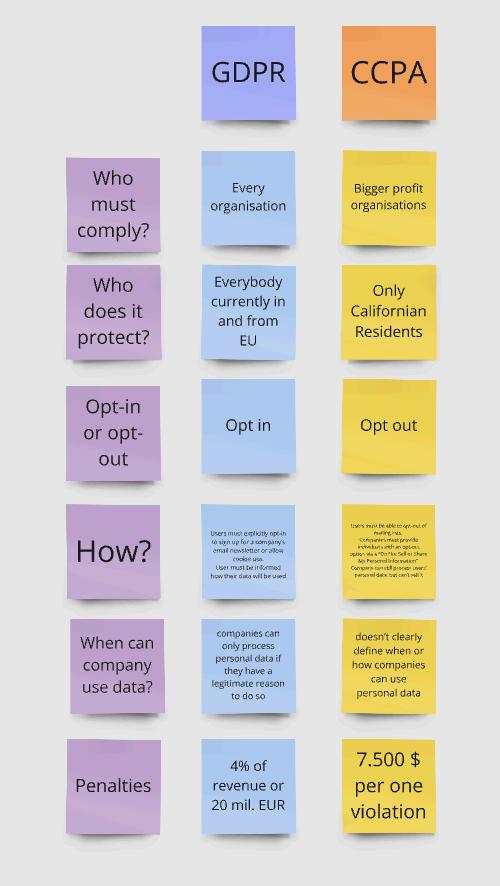
● Debateonprivacy(police)(20min)
Duringthedebateaboutprivacy:
➢ Theteamarguingagainstprivacypresentedthefollowingarguments:
○ Companiescouldn'tprofitbysellingdataanymore.
○ Lesscrime.
○ Why do people deserve the fundamental right for privacy and not the fundamentalrightforsafety?
○ Moreequalworkspaces(lesspaygapbetweensamepositions).
○ Theremaybefewerdivorcesifthingsbetweenpartnersweretrulytransparent.
➢ Theteamarguinginfavourofprivacypresentedthefollowingarguments:
○ Freedomofspeech.
○ Preventionofblackmailing.
○ ProtectionofIP.
○ Controlofyourpersonaldata.
○ Easiertoorganisearevolutionagainstoppressivemanagement.


● IntroductiontoCreativeCommons,Copyright,Patents(10min)
Participantswerefamiliarisedwiththeconceptofpatents.
Participants were familiarised with Copyright, Open source, and all versions of Creative Commonsrights.
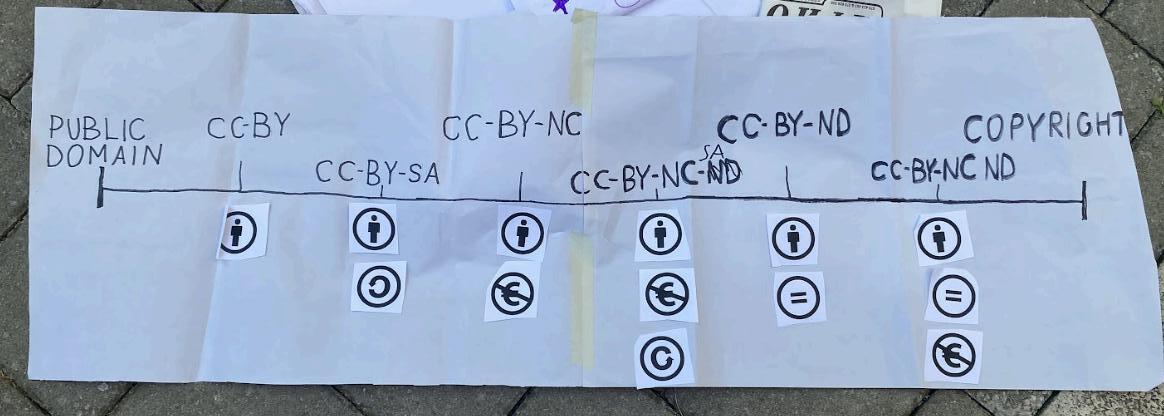
● HowdoesIPaffectPrivacy&Wrap-Up(10min)
Participantsconsideredhowprivacyrightscanimpacttheirjourneyasengineers.
4.FuturePractices
Summary
With the world moving on, the ethical concerns and dilemma is growing on the same level. Such as AI, data security, social needs of corporate environments are trending topics that need modern solutions. In this session, participants will explore how the emerging trendson ethics can contribute to responsibleengineeringpractices,fosteringcollaborationandsharing insightsonhowtoleveragethesetrendsforpositiveimpact.
MinutesoftheSessioncanbefoundhere: [Minutes][Day3]Futurepractices
Methodology
● Introduction(5min)
Introductiontothesessionanditsobjectives.
● Emergingtrendsinethics(15min)
Discussion on key ethical trends, examples of how these trends are shaping responsible engineeringpractices,initialthoughtsandquestions.
● What emerging ethical trends and technology do you think will have the biggestimpactonengineeringinthenextdecade?
Artificial Intelligence Ethics: Addressing biases in AI, ensuring transparency, and accountability
Data Privacy and Security: Protecting user data, implementing robust cybersecurity measures.
Sustainable Engineering Practices: Emphasising green technologies and sustainable resourcemanagement.
Corporate Social Responsibility (CSR): Companies' responsibilities towards society and theenvironment.
EthicsinBiotechnology:Geneticengineering,cloning,andtheethicalconsiderationsaround thesetechnologies.
Diversity and Inclusion: Promoting equal opportunities and a diverse workforce in engineeringfields.
● How can engineers stay ahead of these trends and prepare for future ethical challenges?
● What skills and knowledge will be essential for engineers to navigate future ethicaldilemmas?
● Groupactivity(15min)
Participantsaredividedintosmallgroupsof4.Theydesignequipmentforridingadragon.
● They are told to focus on using sustainable, economic, environmentally friendly,andsociallyresponsiblematerials.
● Theyneedtodrawtheequipmentandlistthematerialsused.
● Theyshouldlistthematerials.
● Present(5min)
Thedesignsarepresented.
● Discussion(20min)
After the presentation, a discussion is held onhowtoleveragethesetrendingtopicsandtheir useinethics.
● How does it feel to be able to design equipment with or without restrictions? Whatarethedifferencesbetweenusingnewtechnologiesandnotusingthem?
● Do you think it isbeneficialtousethem?orwhatarethedrawbacksofhavıng accesstoallthesetechnologıes?
● What is more sustainable in various aspects of engineering? elaborate a bıtın eachpıllar
● Is it fair to use them? Are they used uniformly and responsibly regardıng dıfferentfıeldsandcountrıes?
● Howcanweımplementaunıformuse?Canyouthınkstrategiesandinitiatives thatcanbeimplementedtoleveragethesetrends?
● What barriers might exist to implementing these trends, and how can they be overcome?
● HowcanAIbeusedethically?
● How can companies and engineers implement ethical trends effectively in theirprojects?
Outcomes
● Introduction(5min)
● Emergingtrendsinethics(15min)
The aim of this group activity was to identify different emerging trends that we should considerfromnowonintheengineeringworld.Thegroupsidentifiedthefollowing:
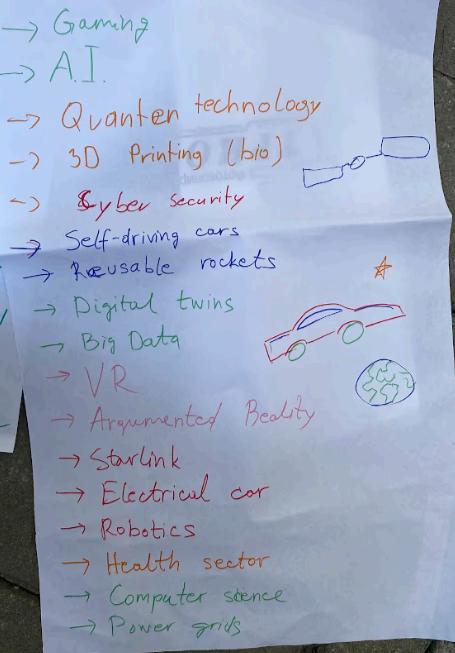


AIandquantumandnanotechnologyaretheonesmorepresent.
● Groupactivity(15min)
Once the trends and new technologies had been identified, we wanted toassesstheimpactit makes using them vsnotusingthem.Inthisgroupactivityweallowed2teamstouse/include intheprocessanyofthebeforementionedtechnologies,whiletheother2teamscouldnot. Theydesigneddragonridingequipmentandpresentedit.
● Present(5min)

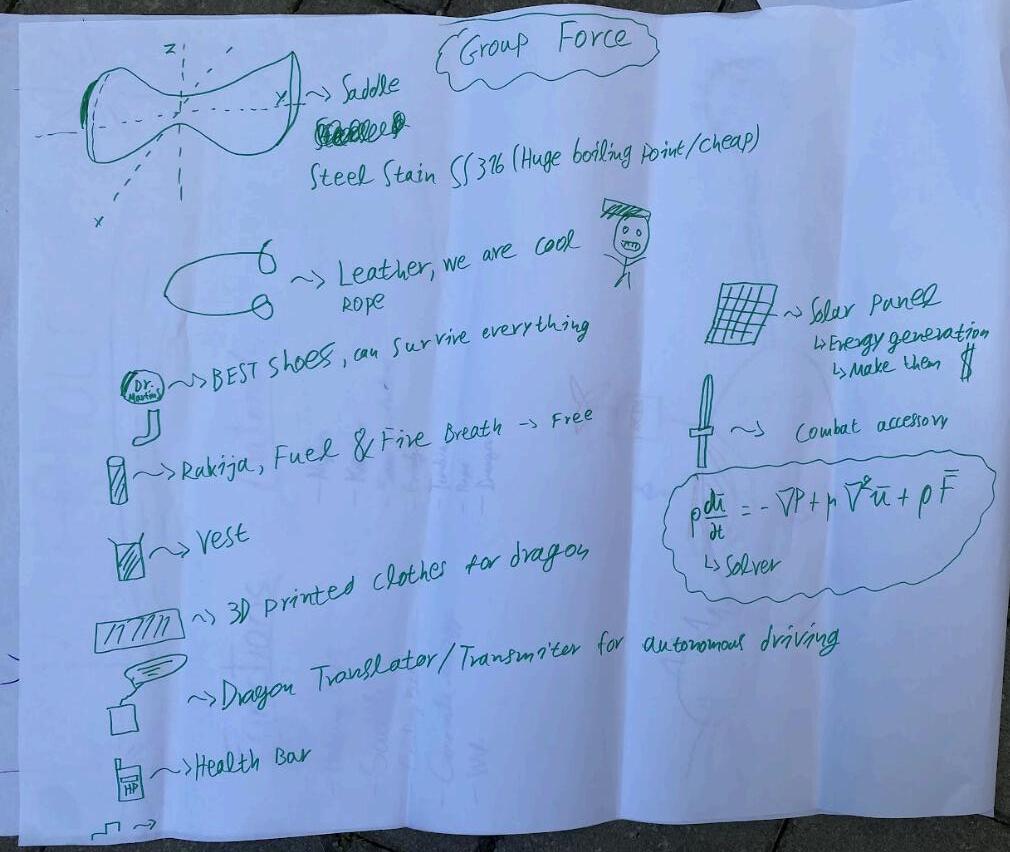
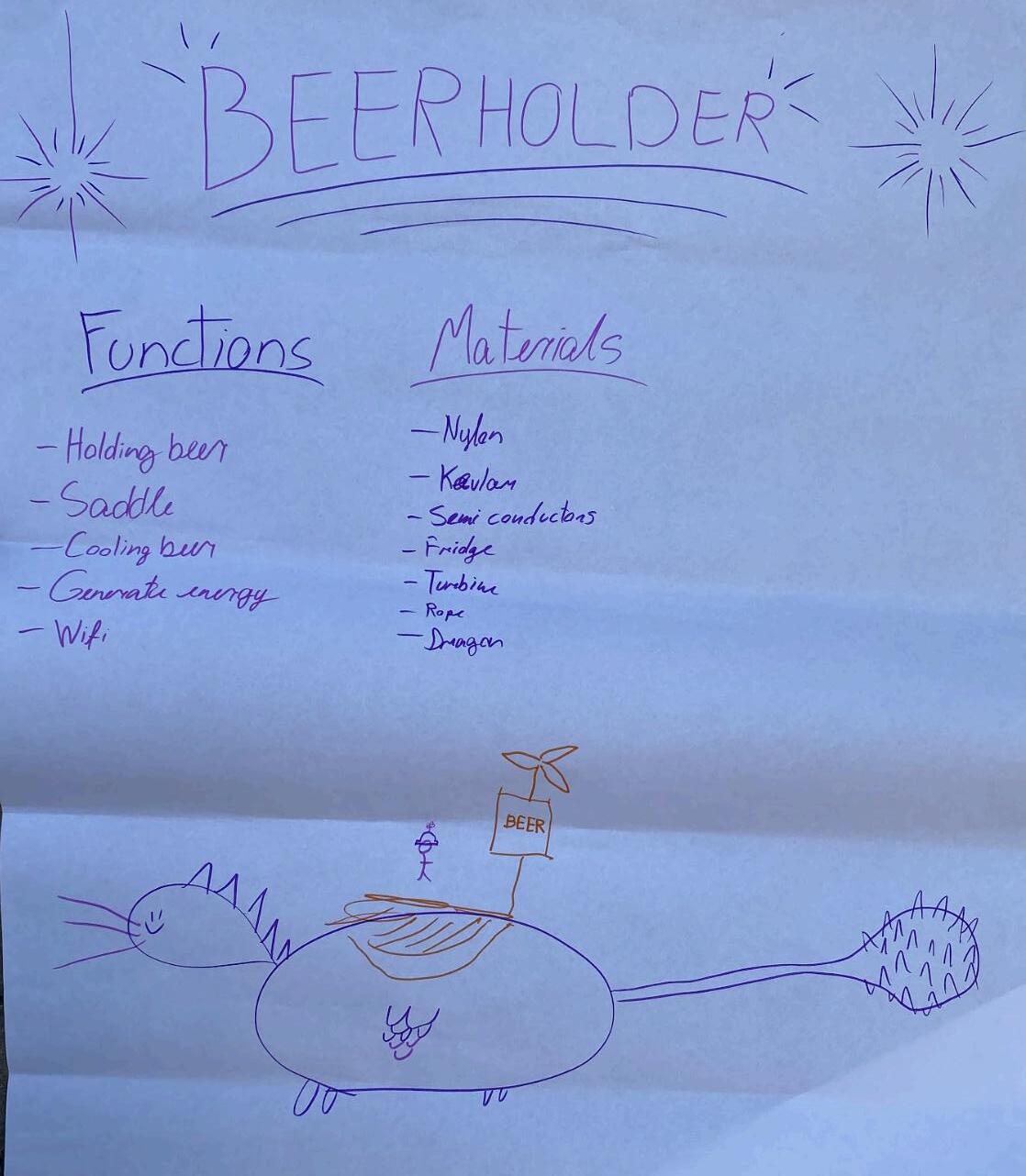
● Discussion(20min)
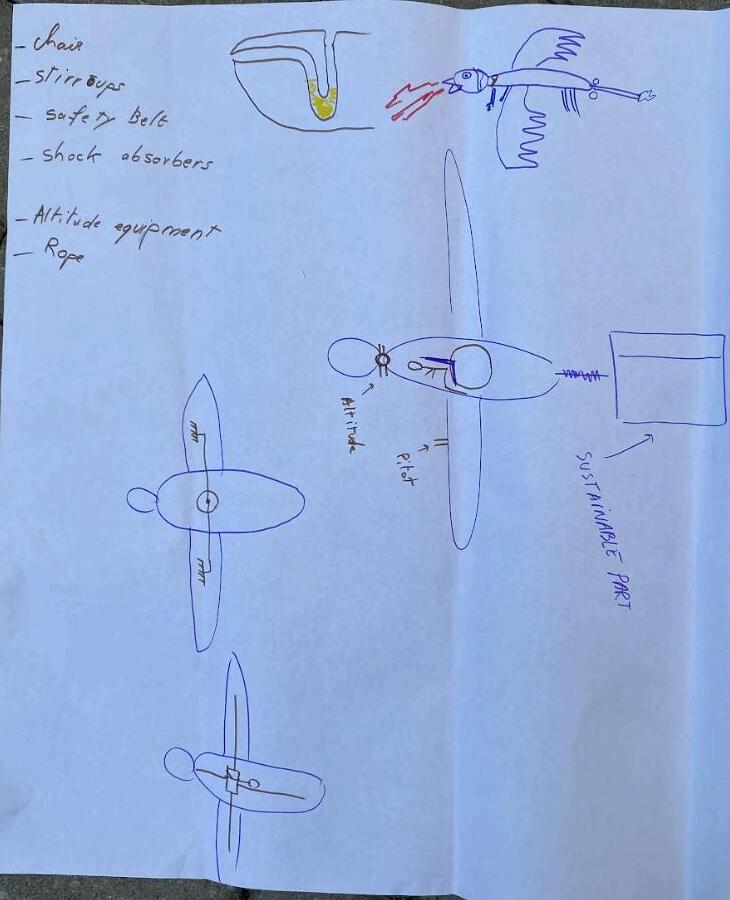
The group discussed AI's roleinengineering,focusingonitsbenefits,challenges,andimpact on creativity and sustainability Perspectives varied, with some participants viewing AI as overhyped, while others recognized its potential for innovation in areas like biofuels and material efficiency The discussion also explored how restrictions affected creativity, with participants noting that working without limits sometimes made tasks feel less serious, thoughoutcomesweresimilarwithorwithoutconstraints.
Key concerns included over-reliance on AI,withworriesaboutstiflingcreativityandmaking engineers complacent. Some participants expressed concerns over AI’s growing energy demands, though others saw opportunities for AI to improve different fields, for instance renewable energy systems. There was consensus thatAIisnotuseduniformlyorresponsibly acrossfieldsandcountries,makingitdifficulttoimplementuniversalethicalstandards. The discussion revealed a nuanced understanding of the role of technology in modern engineering. Participants recognized both the benefits and drawbacks of usingAI,withmost
agreeing that while it can enhance efficiency, it must be managed carefully to avoid dependency and ensureresponsibleuse.Therewasalsoanawarenessoftheglobaldisparities inAIadoption,reflectingtheneedforbettergovernanceandeducationarounditsethicaluse.
ProposedStrategiesforLeveraging
EthicalTrends:
1. ContinuousFeedbackLoops:Participantsemphasisedtheimportanceofintegrating continuousimprovementandfeedbackloopstoensureAIandothertechnologiesare usedethically RegularevaluationsofAI'sperformanceandimpactoncreativitycould helpmitigaterisks.
2. PromoteResponsibleAIUsage:Encourageengineerstomaintainabalancebetween usingAIforefficiencyandpreservingcriticalthinkingskills.Educationalinitiatives couldfocusonthisbalance.
3. Energy-EfficientAIDevelopment:Supportresearchintoreducingtheenergy consumptionofAIsystemswhilestillexpandingtheircapabilities,andaligning technologicaladvancementswithsustainabilitygoals.
5.OverviewontheCurrentSituation Summary
Not every country in the world practisesthesamethingsorusesthesameeducationsystems. Some countries have different university exams, some countries don’t have them, dependencies on scores are different from one country to another, and consequently higher educationstyleschangefromonecountrytoanother.
By this session, it is aimed that participants can be familiar witheachcountry'swayofwork in order to think holistically when it comes to creating a curriculum plan. Participants set in an MUN format to discuss some topics regarding theeducationalmattersandtheirsystemin their countries. This way it waseasyforthemtogatherideasinthenextsessionsintheevent andinthefinalproject.
MinutesoftheSessioncanbefoundhere:
[Minutes][Day3]Overviewonthecurrentsituation
Methodology
● Introduction(10min)
Attendeesareawareoftheobjective,theagenda,andgroundrules. IntroductiontowhatMUNis,howtheproceduregoes.
● PositionPapersandOpeningSpeeches(20min)
Participants are gathered as groups of countries, Spanish people represent Spain, Turkish peoplerepresentTürkiyeandtheyarecalleddelegates.
Participants are given 10 minutes to understand and write an explanatory paragraph for the situationoftheengineeringeducationintheircountry. They will tackle thenamesofgenericclasses,whatkindofengineeringfieldstheyhave,how involved students are for their own education, how the communication with thefacultygoes like…
Each country will read their paragraph to the rest of the delegates as a part of the opening speeches. 60 seconds for each country will be given. All the speeches must be written seriouslyandinacademicenglish.
● Groupdiscussion(50min)
Facilitatorswilltaketheroleofchairmans. Thegroupwillstartdiscussing;
- EducationinEngineeringField
- What are the classes given in engineering education? Which of the classes arenecessaryornot,whatskillsdowegetfromtheseclasses?(20min)
Identify what CAN BE changed in the curriculum. Clustering of classes in engineering education.
Breakfor5mins
- Ethics/Responsible Engineering inside the Education, how involved is it? Whatshouldbeinvolvedmore?Whatmoreskillscanbegotfromthesetopics?(15min)
Identifywhatspecifictopicsshouldbeincludedinengineeringeducation.
Participants will decide on the time required for each discussion by themselves, they can movethetopicinsidetheproposedframe.
● ResolutionPapers(20min)
Participants form alliancestogether,andtheylistdownthenecessaryandunnecessaryclasses they clustered in their group. Afterwards they write down the specific topics of ethics they believe that should be included in the curriculum. And the positive and negative aspects of bothpoints. Oncetheyaredone,thepresent.
● PresentationandVoting(10min)
Presentation,questionsifneeded.2minutesforeachgrouptopresent. Voting.
5bigcountriescanveto.
● Messtime(10min)
Outcomes
● Introduction(10min)
Attendeesmadeawareoftheobjective,theagenda,andgroundrules.
● PositionPapersandOpeningSpeeches(20min)
AsmallexplanationoftheMUNformathasbeenmade.
● Groupdiscussion(50min)
Participants preferred to start with proposing new topics and then voting on the proposed topics.
- EducationinEngineeringField
Participants started by pointing out similarities and differences in different engineering fields. They moved on bydefiningthefundamentalclassesinthefaculties.They alsotackledtheprioritisedsustainabilitypractices,suchasinclusivity,diversity,andethics. Apparently some of the countries are focusing on soft skill development of the engineers, while some focus on a heavy education and knowledge on terminology. Global education standardsarelookeduponintheeducationofallcountries. The participants moved on by ethical working and area of practising in universities. Some countries supported providing all the information available to let thestudentsdecideontheir interest, and some countries claimed they already have some practices. Up to date informationprovidedbytheuniversitieswashighlightedintheconversation.
- Ethics/Responsible Engineering inside the Education while collaborating with externalpartners
Engaging companies with students are creating networking opportunities redeemed to be important. Collaboration with the industry other than internships might be interesting for students. However, the relationship between students and companies are concerningduetolabourwagesandnotfinishingstudiesontime.
● ResolutionPapers(20min)
Participants were informed that they need to create alliances based on real-life conditions to come up with a resolution paper. How to write the paper was explained. All the groups worked on finalising the necessary and unnecessary partsofthecurrentcurriculuminSTEM whilethinkingaboutethicalnecessitiesagraduateshouldhave.
● PresentationandVoting(10min)
Therewere4alliances:
● Balkans&Russia(1)
● EuropeanUnion(2)
● AmericanContinents(3)
● Turkey(4) (1):
Unnecessary:Civillaw,Uselessprojectsthatexistjustforthesakeoftheirexistence
Necessary: Languages, Entry level classes of science (maths, physics), Internships, Leadershipandteamwork,applied,bio,environmentalethics
(2):
Unnecessary:Sheernumberofsubjectsinthecurriculumrightnow.
Necessary: Projectschosenbystudents,offeredindifferentareas.
(3):
Unnecessary:PriceofUniversity
Necessary: Technical classes, but more focus on hands-on experiences. Engineering ethics, economics,communication,responsibleinnovation,sustainability.
(4):
Unnecessary:History,languages,philosophy.
Necessary:Religion,Militarydevelopment.
Basedonvoting,theresolutionoftheEuropeanUnionpassed.
6.EthicalPhilosophy Summary
This session aims to familiarise participants with ethical philosophy and introduce them to some of the theories so they can see how to focus on dilemmas and the possible reaction to dilemmas in philosophy. Participants are expected to see how ethics is based on many differentthings,andactionscanresultingoodeventhoughthewayshowsdifferently
MinutesoftheSessioncanbefoundhere: [Minutes][Day3]EthicalPhilosophy
Methodology
● Introduction(5min)
● Debate(25min)
Debateonaphilosophicalaspectforparticipantstogetinthemindsetforthesession.
- Taking5minutesforthemtopreparetheirarguments.
- 2minsperteamtopresentthearguments.
- 3minstogobacktotheirteamandtocreatecounter-argumentsafterlistening.
- 2minstopresentthecounterarguments.
- Therestistheirtimetodebate(10mins).
● FoundationalEthicalTheories(15min)
Some of the main theories (Utilitarianism, Deontology, Virtue ethics) regarding ethics are presentedtotheparticipants.
● Reflection(5min)
Shortreflectionandsummaryofthedebateismade.
● GroupActivity(15min)
We’ll hand participants some real world cases that they’ll have to discuss and explain the decisionstheywouldtakeandthephilosophicalthoughtbehindit
● Presentation(10min)
Presentationsandquestions
● Wrap-upandMesstime(15min)
-Howdiditfeeltojustifyanimproperethicalaction?
-If you deal with these ethical situations yourself, what would you do differently? Or the same?
-Howdoyouthinkwerunintothesedecisionmakingprocessesanddilemmasinreallife?
-Inwhichmentalityshouldwebeintosolvetheminthebestpossibleway?
Outcomes
● Introduction(5min)
Participantsfamiliarisethemselveswithasituationtheyaregoingtodebateabout.
● Debate(25min)
Participants engaged in debate on the topic of actions seen in a short clip from the movie “How to Train Your Dragon”. The team arguing in favour of the protagonist's action mainly focused on the personal virtues of the protagonist, while the teamcondemningthemfocused onthatactionshetookwereinherentlywrong.


● FoundationalEthicalTheories(15min)
ParticipantswerefamiliarisedwithconceptsofUtilitarianism,Dendology,andVirtueethics.

● Reflection(5min)
Participants were givenexamplesofhowtheyalreadyusedpreviouslymentionedconceptsin previousdebate,withoutthemnecessarilyknowingit.
● GroupActivity(15min)
Participants were given moral dilemmas to analyze using all three of the concepts, thus furthering their understanding of them. Teams of participants shared their opinions on given dilemmastootherteams.
● Presentation(10min)

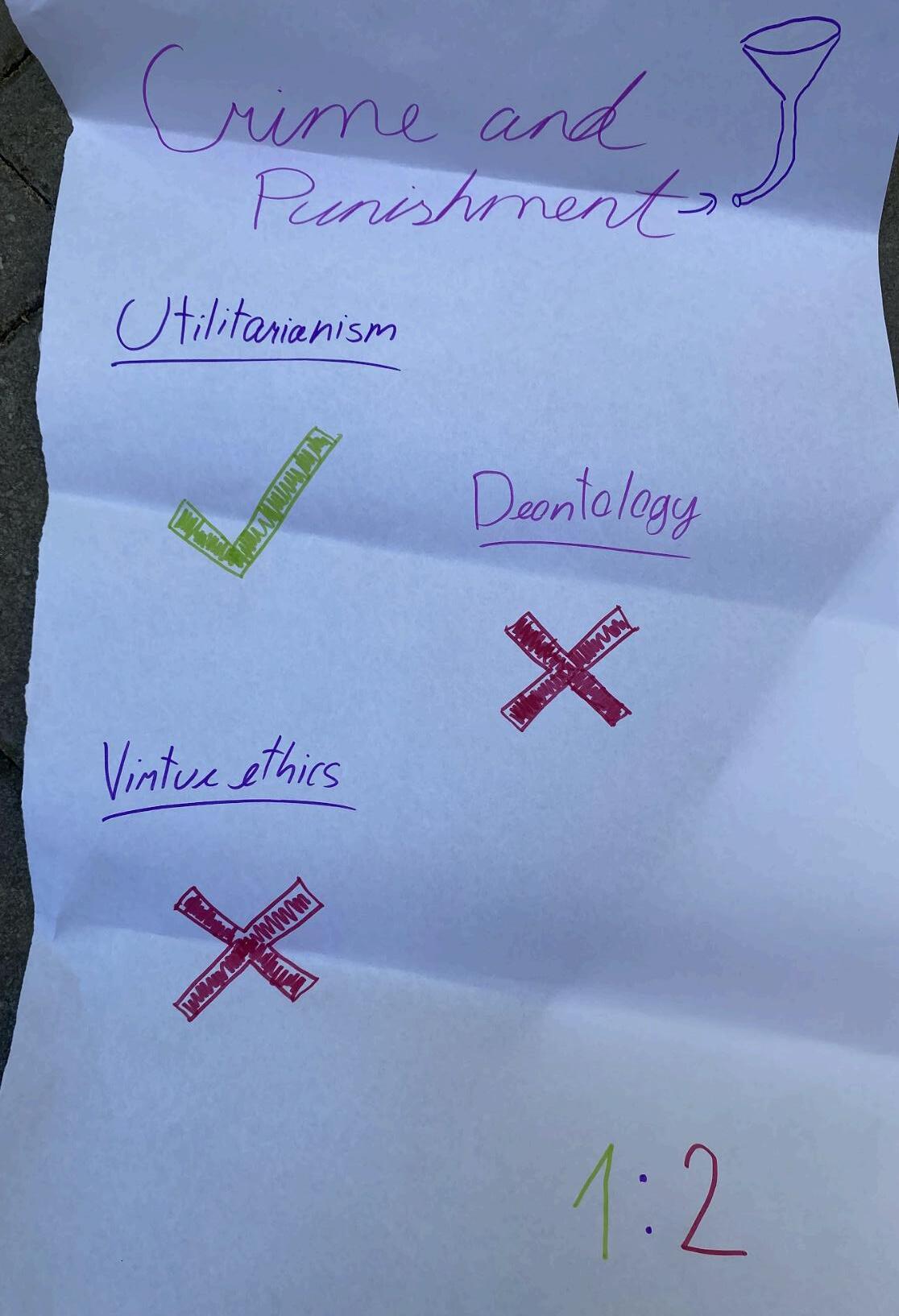
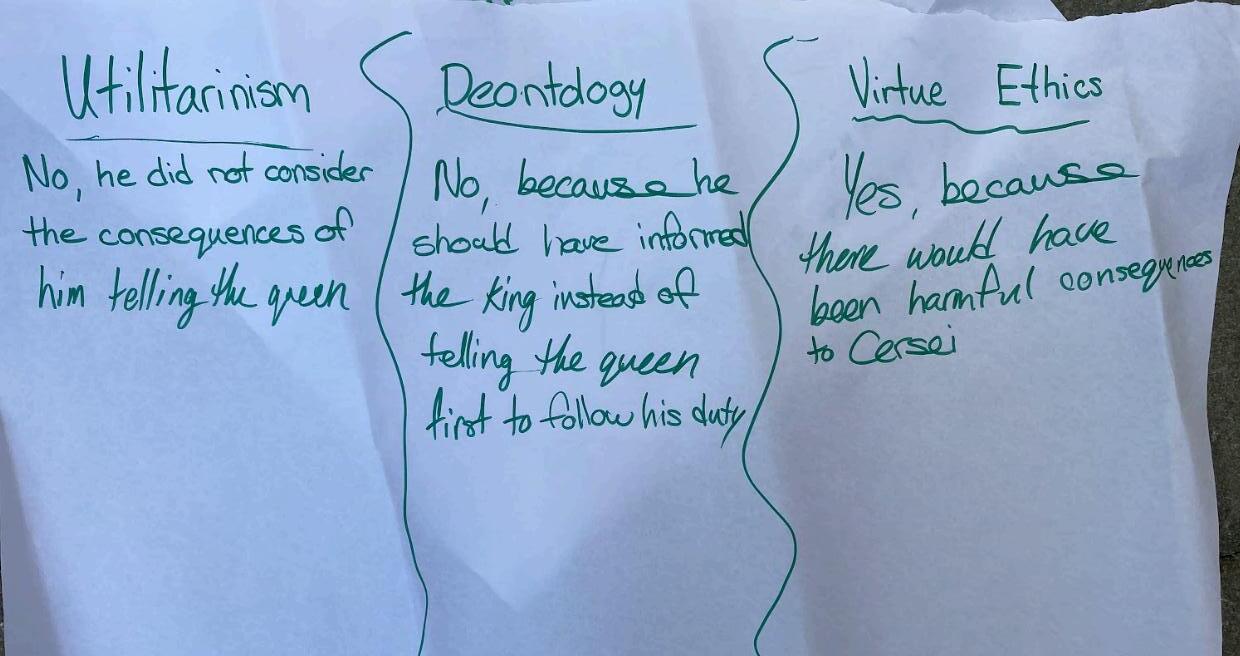

● Wrap-upandMesstime(15min)
-Howdiditfeeltojustifyanimproperethicalaction?
Participants mention that it wasn’t hard and comment on number of different perspectives thatdevelopedinteamduringexercise..
-If you deal with these ethical situations yourself, what would you do differently? Or the same?
Participants would not increase communication with family, decrease communication with enemiesandingeneral,notmurderpeople.
-Howdoyouthinkwerunintothesedecisionmakingprocessesanddilemmasinreallife?
Participantsdefaultedtoutilitarianapproachtodilemmasintheirdailylives.
-Inwhichmentalityshouldwebeintosolvetheminthebestpossibleway?
Mentality of dooing what is best for everyone, and not what if expected from you was proposedforthis.
8.CaseStudyontheStudentApproachforImplementing sustainabilityintoUniversityEducation Summary
Thissessionisusedasawrapupfortheprevioussessions,togatheragenericideasharingon thesessionsandsomespecificquestionstoeasedowntheprojectmanagementprocessfor participants.Thesessionisconstructedasadiscussiongroup.
MinutesoftheSessioncanbefoundhere: [Minutes][Day4]StudentApproach
Methodology
Part1oftheSession
● EthicsinSTEMCurricula(1h10m)
● Introduction(5min)
Attendeesareawareoftheobjective,theagenda,andgroundrules.
G2Kgame:Name,LocalGroup/University
● Recapoftheprevioussessions(15min)
They do a recap for the whole previous sessions and try to point out the learningpoint,how ethics and responsible engineering works and what are the take outs, so we can link it with education.
● Howshouldtheeducationbelike(15min)
They already discussed in the previous sessions what the main descriptions and main ideas are.
-Howcanyoumakeithappenthrougheducation?
-Whatshoulduniversitieschangerightnowtotacklethistopic?
-With what kind of activities ethics and responsible engineering can be integrated into education?
-Howcanweensuretheethicscultureisintegratedintoourlivesaftereducation?
● Groupactivityofmixedpeople(15mins)
One person from each group comes together, so each activity group would have different peoplewhowon’tbeworkingtogether.
- What are the specific classes and activities you think should be included to educate peopleonethicsandresponsibleengineering?
- Whatshouldbethelearningactivitiestoenhancethelearningprocess?
Brainstorminganddiscussionontheactivities.

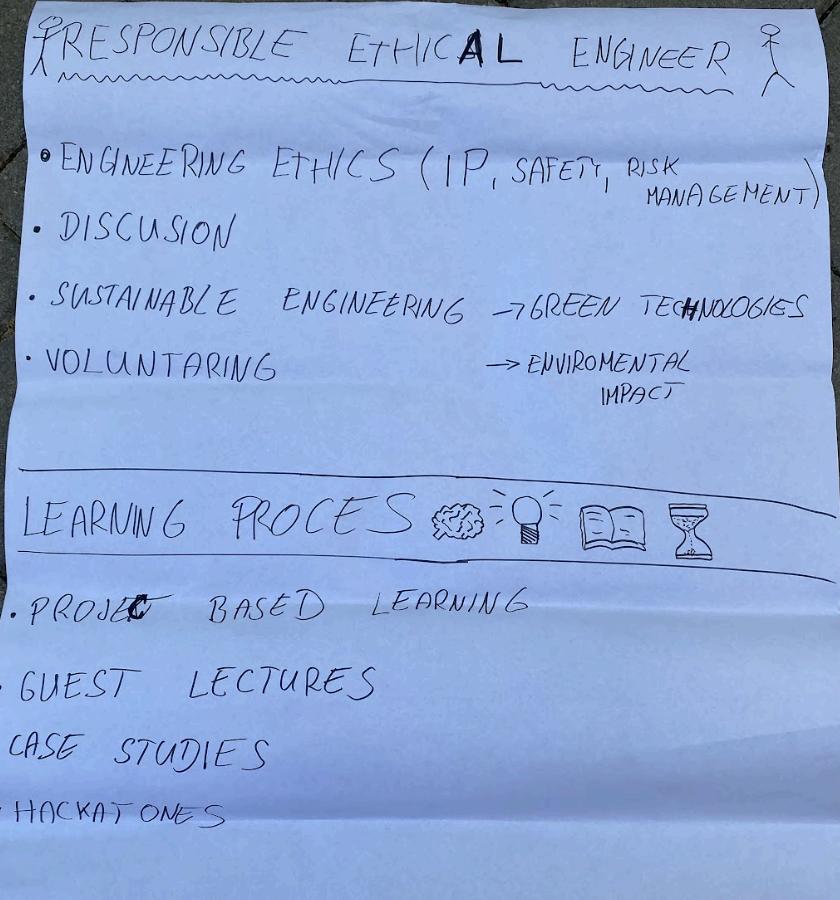
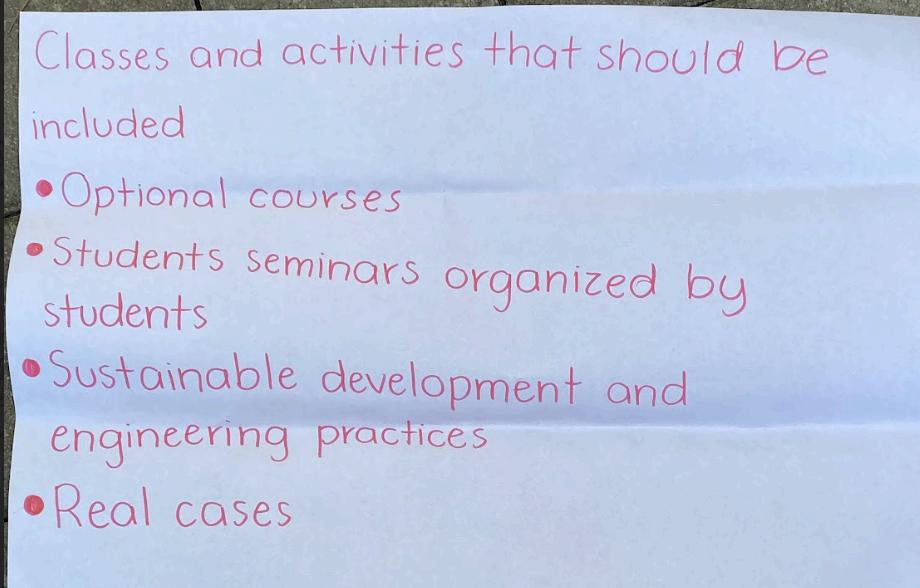
● Present(10min) Theyhavetopresenttheirwork.
● Discussion(10min)
-Howwasittohavethepowertochangeeducation?
-Doyouagreewiththeteams?Didyourealiseanything?Wasanythinginterestingforyou?
-Aretheseeffectivetohaveinthecurriculumtocreatethecultureofethics?
-If you could take one learning activity to the education system, what woulditbe,andwhy? Whatisitseffect?
Part2oftheSession
● CareerGrowth(40min)
● Discussion(15min)
-Whatarethemostrelevantskillstobetheidealethicalandresponsibleengineer?
-What are the skills that companies require for futureengineerstohave?(thisisbasedonthe currenttrendssessionandthecompanyengineerstickman)
-Howcanapersondeveloptheirskillstobeanethicalengineer?
-Howcantheschoolhelptodevelopthisskillset?
-Forcompaniestobeabletofollowuponthat,whatcantheydo?
● Ihaveadream…(15min)
They will write their dream 50 years from now, how this change they'd like tohaveresulted in?Howdoesthefuturelookliketothemwiththeidealcurriculumbeingapplied? With thisactivity,theycanseetheirgoalsforthefinalproject,andoncetheystarttheyhavea thinginmind.
● Messtime(10min)
Part3oftheSession
FinalProjectDescription: FinalProject
Outcomes
Part1oftheSession
● EthicsinSTEMCurricula(1h10m)
● Introduction(5min)
Participantsgotfamiliarwiththeagendaandtheconcept.
● Recapoftheprevioussessions(15min)
Here participants tried to understand the personality of the engineer once they graduate; and realised the current system creates stereotypical people in engineering. When they tackled how responsibility can be achieved through education, based on their previous learning points, they came up with some characteristics such as risk determination, implementation skillsandassessment;goodcommunicationskills,softskills.
● Howshouldtheeducationbelike(15min)
-Howcanyoumakeithappenthrougheducation?
-Whatshoulduniversitieschangerightnowtotacklethistopic?
-With what kind of activities ethics and responsible engineering can be integrated into education?
-Howcanweensuretheethicscultureisintegratedintoourlivesaftereducation?
To these questions, participants mentioned that education should be goal oriented, encouragingstudentsintoextracurricularactivities,andaligningwiththecompanypractices.
When asked about ethics, participants mentionedstudentsbeingonboardwithacademicsfor curriculum creation, and continuous feedback on the system; data gathering ways should be introduced to check the process. And it was highlighted that different European countries haveverydifferentpractices.
Regarding being a responsible engineer after graduation, people mentioned thatstabilityand governmentalknowledgeseemedtobeimportanttokeepthepracticesongoing.
● Groupactivityofmixedpeople(15mins)
● Present(10min)
Theyhavetopresenttheirwork.
● Discussion(10min)
-Howwasittohavethepowertochangeeducation?
-Doyouagreewiththeteams?Didyourealiseanything?Wasanythinginterestingforyou?
-Aretheseeffectivetohaveinthecurriculumtocreatethecultureofethics?
-If you could take one learning activity to the education system, what woulditbe,andwhy? Whatisitseffect?
To these questions, participants mentioned the potential challenges on change management; such as backfiring from academicians. Due to change in education systems, participants cannot agree on one specific change; or that the universities are unwilling to change their systemofeducationortoapplefeedback.
As a final word participants realised that changing the education doesn’t help to create a cultureofethicsontheirownbutthereisassistanceneeded.
Part2oftheSession
● CareerGrowth(40min)
● Discussion(15min)
-Whatarethemostrelevantskillstobetheidealethicalandresponsibleengineer?
-What are the skills that companies require for futureengineerstohave?(thisisbasedonthe currenttrendssessionandthecompanyengineerstickman)
-Howcanapersondeveloptheirskillstobeanethicalengineer?
-Howcantheschoolhelptodevelopthisskillset?
-Forcompaniestobeabletofollowuponthat,whatcantheydo?
When asked these questions, participants once again collected their opinion on the ideal engineer from acompanypointofview.Theygatheredthatthesequalitiesarealsothingsthat companies are asking for. They also think it is important that the engineer improves himself by workshops, improving soft skills, understanding different fields of engineering and working conditions, and being morally determined. They also mentioned that the mentoring system is important. They also think that the role of the university is to provide an
environment for a student to be able to improve themselves ethically and soft skill-wise; a glimpseofthefutureshouldbeshowntostudents,anditshouldprovidenetworking. For companies when it comes to ethical practices, itisagoodpracticethattheydon’taskfor genderintheCVorapicture.
● Ihaveadream…(15min)
● Messtime(10min)
Part3oftheSession
FinalProjectDescriptionisexplainedtotheparticipants.
9.ProjectOutcomes
Summary
This project aimed for participants to create and implement a sustainable university curriculum with additions of extracurricular activities and promotion of the curriculum practices in order to provide solid data and provide examples on the matter while plotting a planfortherealisationofthecurriculum.
With the project outcomes, the goal was tomakesurethereareanswersforseveralquestions thatbecamethefundamentalelementsoftheeventdesign:
● Gather students' opinions about the meaning of the topic “responsible engineering” andpossiblewaysofimplementation;
● Identifybestmethodsforapplyingtheinsightsgatheredthroughtheevent;
● Create a strategy proposal for implementation of the methods forvariouseducational systems(formalandnon-formal);
● Defineandprioritisetacticsforshort-termandlong-termimplementation;
● Mapoutpotentialwaysforethicsintegrationdeemedfeasiblebystudents.
MinutesoftheSessioncanbefoundhere:
[Minutes][Day5]FinalEvaluationPresentations
Projectdescription: FinalProject
Methodology
Eachteamwasprovidedwith5htoworkontheirprojecttogetherwithfacilitatorsin attendance,and15’topresentandaQ&Afollowedafterwardsoncethepreparationswere done.
Outcomes
Team1
Presentation: Finalprojectforbseskopje2024.pdf
This team started off with checking on some curriculum information regarding engineering, andimplementedethicsrelatedclassestotheexistingones.
The team kept the same system of studies as a 4 year plan for bachelor’s degree in engineering. Each year passing the team decided to merge required classes with the ethical relatedonesinordertousethemaspracticalclasses.
The team came up with promotional ideas by using memes, and produced some extracurricular activities such as TED Talks,ResearchGatherings,WorldCafediscussionsto explainsustainabilityandmakeitaccessibletoeveryone.
In order to measure the impact of the plan they created, they came upwithAlumniSurveys, employmentratios,employerfeedbacksystemandpost-graduatestudies.
The team also decided to have partnerships. One of the highlighted ones was about a BEST for Teachers to make sure the quality of education stays stable and that teachers have a motivatingorganisationfortheirworkthatissupportedbyeventsonsustainabilityandethics.
Team2
Presentation: Group2FinalProject.pdf
This team focused on having a unified curriculum for Europe, that is for 4 years and is a bachelor’sprogram.
Onthefirstyear;
● Ordinary engineering lessons (Mathematics I&II,PhysicsI&II,GeneralChemistry, EnglishLanguage)
● LabClasses(IntroductiontoProgramming,PhysicsLab)
● Optional Classes (Philosophy, Other Language, Human Rights, Environmental Sciences)
● Introductiontoethicalengineering
Onthesecondyear;
● Ordinary engineering lessons (Mathematics III & IV, Numerical Analysis, Advanced ProgrammingCalculationswithapplicationtotheengineeringspecialty)
● LabClasses(Basedontheengineeringspecialty)
● OptionalClasses(careerrelatedclasses)
Onthethirdyear;
● Specialtyclasses(Basedonthecategory,3respectiveandadvancedlessons)
● Project/Labclasses(Asemester-longprojectwithaspecifictask)
Onthefourthyear;
● Bachelor’sThesis
The team focused on a 5 year transition plan, while retraining teachers in the process and providingthemwiththeneededmaterials.
The team envisioned the first year as a data gathering opportunity and the second year performed as a pilot study to start the implementations. Dependingonthefeedbackgathered in the first two years, thethirdyearwasforrevisionandimplementation.Inthefourthyearit was planned to have a final draft ofthecurriculumwiththenecessarymaterialssuchasclass syllabuses, information, examination types, and in the fifth year it was aimed that the new curriculumwasreadytouse.
As in all the change management processes, the sixth year and continuing is for evaluations andimprovementsonatimelessperiod.
The team also tackled some extracurricular activities like summer courses and academic exchange programs; discussion clubs, networking events, board game events, VR events, eventstohighlighttheresponsibilityofanengineer
In order to promote these activities and thecurriculum,theteamworkedonsocialmediaand internetpromotion,andprintedmaterials.
The team decided to cooperate with NGOs and SNGOs as well to achieve the unified curriculum idea. Their aim is to have conferences and discussions with the NGOs and participateineventstoencouragestudentsandmakesurethereisunionity
In order to evaluate the whole process the team decided tomoveonwithgivingassignments to students to analyse the curriculum, watch out for metrics to see how the change is happening and how the atmosphere is like; and comparison of alumni before and after the changeofthecurriculum.
Team3
Presentation: BSEFinalProject2024-Group3.pdf
This team decided to have a plan of 6 years for a bachelor’s degree program. The team also workedonunifyingthecurriculumthroughoutacountryoraregion.
Thespecificationsforeachyearisasthefollowing: Onthefirstyear;
● Gather deans and student representatives from multiple universities to gather their inputonimplementationandgivethemtheinformationtoretrainfaculty
● Mathematics I and II, Physics I, Computer Programming I, Materials Science I, IntroductiontoEngineeringI,Engineering,CommunicationsI,DesignI
IntroductiontoEngineeringI
EngineeringCommunicationsI
Students will learn about their regions applicable engineering laws, ethical decision making, and project management. Case studies will be given of ethical decisions related to engineering and students will have to apply different ethical philosophies in these situations.
Students will learn how to communicate in a professional setting through creating reports, memos, and public speaking. Possible assignments will include creating memos as if it were addressed to a supervisor providing an update on work, creating aresearchreport andspeech,orcreatingawellroundedCVpackage.
DesignI
Students will learn about the early stages of the design process including defining the problem, identifying constraints and requirements of the solution, and workingingroupstocreateasolutionforaproblem.
Onthesecondyear;
● Implement all courses in pilot universities around Europe in variety of different countries
● Mathematics III and IV, Alternate Language, Courses I, Advanced Alternate, LanguageinEngineering,FieldSpecificTechnicalClasses
AlternateLanguageCoursesI
Students will learn the basics of another language. Multiple choices will be offered and the students can pick which languagetheywillwantto learn.
Advanced Alternate Language in Engineering This course will focus on becoming proficient in technical language of a secondary language. By learning this content, students will be able to skillfully use technical terms in another language related to the engineeringfield
Onthethirdyear;
● GainfeedbackandreviseplanusingKPIs
● Sustainability in Engineering I, Engineering Economics I, Field Specific Technical Classes, InternationalStudies(EU)ORInternationalStudies(Worldwide)
InternationalStudies(EU)
Students will learn about the lawsregarding engineering in the EU, country relations throughout the EU, andanyotherapplicable engineering information connected to the EU
InternationalStudies(Worldwide)
Students will learn about the differences in engineering laws throughout the world, current relationships of countries, and any other applicable engineering information relatedtotheircountry.
SustainabilityinEngineering
EngineeringEconomics
Onthefourthyear;
Students willlearnabouttheUNsustainable goals and look at case studies of real life problems andprojectswhichcontainaspects ofthesegoals
Students will learn about scheduling and budgeting of a project, materials cost estimation,andcostevaluationofasolution
● Present feedback to officials from universities in Year 1 and gather moreuniversities toimplementtheplan Onthefifthyear;
● Gather feedback from those universities and alumni of university and create a report outliningtheresults Onthesixthyear;
● Total implementation ofplanacrossuniversitiesandcontinuousfeedbackformsgiven tostudents
The team based their bachelors degreeon3yearsandhadthenext2yearsinoptionalclasses andactivities.
When it comes to extracurricular activities, the team decided on having science clubs, festivals, and meetings with alumni; while promoting this plan by using engineer clubs and international organisations. Also using newsletters and careerexchangeswithcompaniesand keynotespeakersorinternshipscameasanidea.
In order to understand and analyse the impact of this system, the team thought of creating surveys to do in classes,informationquestionnaires,andalumnirelationstochecktheimpact aftergraduation.
Team4
Presentation: BSESkopjeGroup4.pdf
This team moved on with identifying the issues on the current system andpointingthemout whileprovidingsolutionsforthoseproblems. Theproblemstheypointedoutinthecurriculumwas:
● CurrentCurriculumsaremissingfocusonsoftskillsandnontechnicaltopics.
● Studentsarelosinginterestinclassiclectures.
● Studentsarelackingindepthcasedbasedworkandconnectionwiththeindustry.
They decided to have the first two years more focused on technical and humanitarian basic classes, whilefrom3rdto5thyears,projectbasedandinternshipbasedclasseswillbeheldin thecurriculum.

Theyaddedsomeadditionalclassestothecurriculumwhileusinga5yearstudyperiod. Theymentionedthattheseclassesshouldbegivenearlyinthecurriculumtocreateinterest:
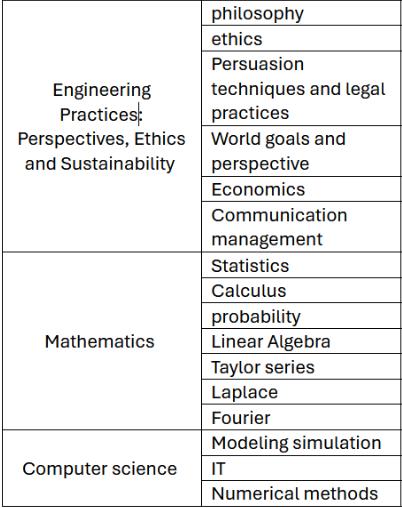
Theyalsocameupwithareverseclassroomideatoencouragenewlearningenvironments andstudentstoparticipateandcontributemoretotheclassrooms.
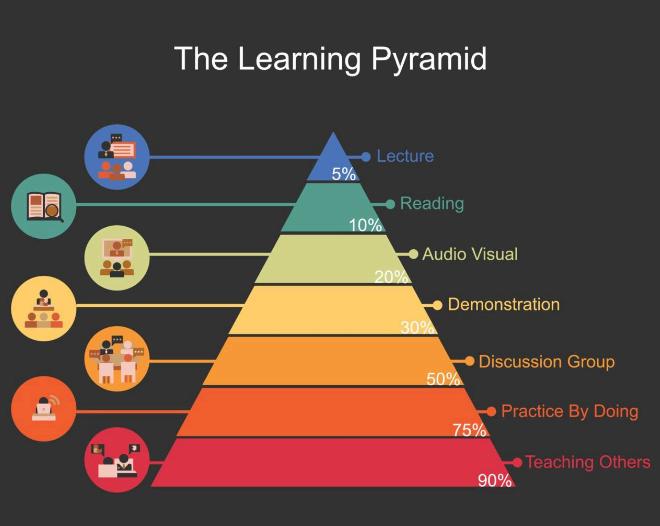
In order to create a better learning environmentandmakesurestudentsarereadyforreallife challenges, the team proiritized having case based projects and SDG based projects for students in the last years. Alsocreatinganinternshipnetworkandprovidingpossibilitieswas awayofthisteamtoequipstudentswithnecessaryskills.
As in extracurricular activities, the team came up with international festivals and student conferences to be held to make sure students get the enough experience and communication fromdifferentaspects.
In order to evaluate this whole process, attendance of students, amount of working hours, amountofpartnershipsandidentifyingtheneedsoftheindustrywasthought.
When it comes to a summary of all the projects made, it can be said that most of the teams focused on the importance of internships; highlighted the strengths of having ethical and humanitarian classes in order to improve the soft skills of students whilestillstudyinginthe university They also mentioned that social activities might motivate and encouragestudents to participate more in sustainable practices if these social projects are done with right intentionsandwithasustainableapproachandpractices. It can be said that the time of studies were mostly 4-6 years for each team, with an approximation of 5. They all decided that fundamental engineering classes necessary as expected but they had a heavier support on introductory classes for engineering and additional language classes alongside with classes to understand sustainabilitybetter During regular curriculums, it canbeseenthatsustainabilyisusuallyapartofaregularlygivenclass to raise awareness, however in each project it is seen that student preferred extra classes in ordertounderstandthetopicanditsrequirementsbetter.
CommentsandSuggestions
Due to the answers and data gathered in the final projects and through the event during sessions, itcanbeconcludedthatthiseventreacheditsresultandprovidedcontentforfurther studieswhilecreatingawarenessfortheparticipants.
For next events and works, it is important to make surethetopicflowoftheeventisworked upon and discussions are not overlapping. This was a strong asset in our event that wewere abletocreattopicsbindedwelltogether
It is also important to make sure there is a very clear task list with task delegations and a timeline for work that ispreparedindeptinadvance;bothfortheorganizersteamandforthe content team. It is also advisable to have a guideline for the organizers to follow regarding communicationwiththeteam,thesemightmakethingseasierinfuture,howeverthecommon practicesarealsofairlysufficient.
Thankyoueveryoneforbeingapartofthiseventandmakingthishappen.
ContactDetails
İremAlpçetin
BSEWroclaw2023Coordinator BoardofEuropeanStudentsofTechnologyAISBL irem.alpcetin@best-eu.org
NadicaKoloska
EducationalInvolvementDepartmentCoordinator2024-2025 BoardofEuropeanStudentsofTechnologyAISBL nadica.koloska@best-eu.org
BoardofEuropeanStudentsofTechnology
BEST AISBL will develop activities in order to help European students of technology to become more internationally minded, by reaching a better understanding of European culturesanddevelopingthecapacitytoworkonaninternationalbasis.
BEST AISBL will serve European students of technology in a non-representative way, in mattersconcerningthemandtheireducation.
EducationalInvolvementDepartment
ThepurposeoftheEducationalInvolvementDepartmentisto:
● increasestudents’awarenessandinvolvementineducationalmatters;
● gather students’ input on educational matters and disseminate it to relevant Higher Educationstakeholders.
